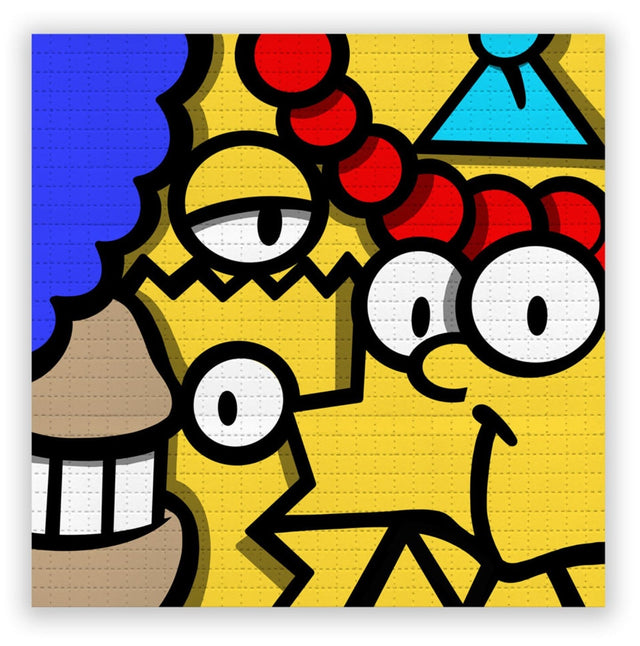
Yellow
-
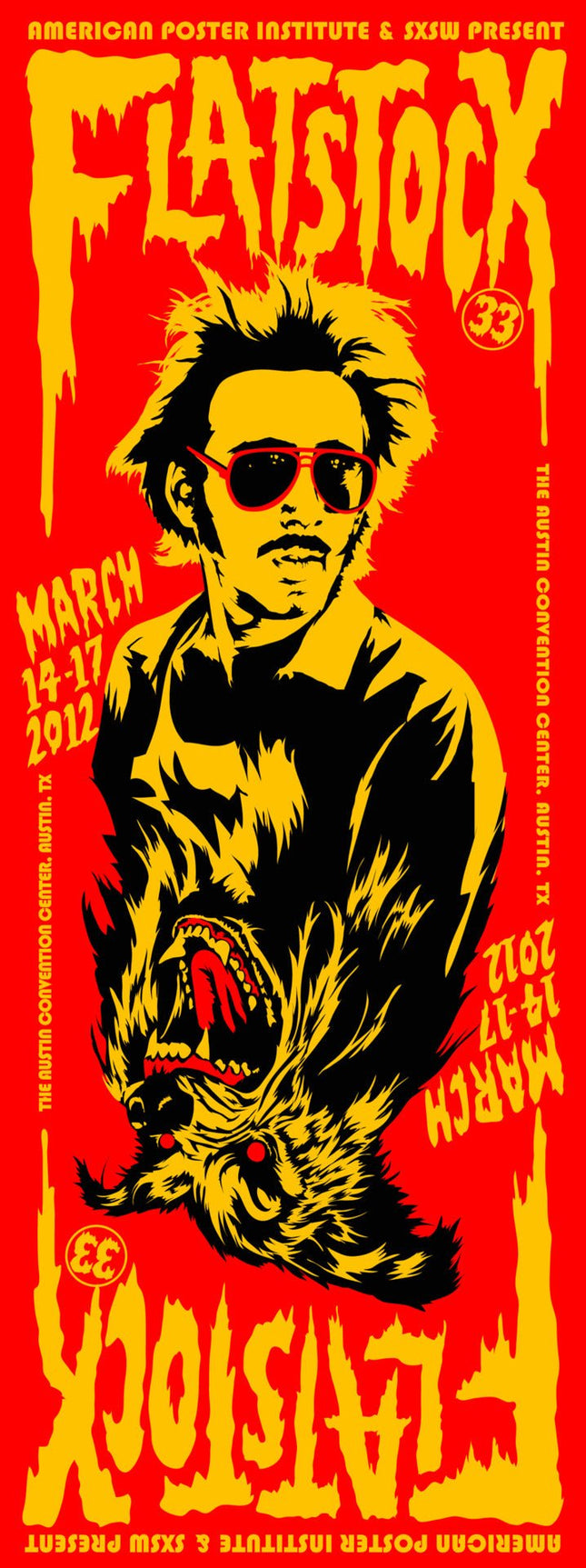
Jeremy Wheeler Flatstock 33 2012 Silkscreen Print by Jeremy Wheeler
Flatstock 33 2012 Event Music Limited Edition Gig Poster 2-Color Hand-Pulled Silkscreen Print Artwork on Yellow Fine Art Paper by Jeremy Wheeler. Number 71 of 71. SXSW American Poster Institute March 14-17 2012 Austin Convention Center Texas
$103.00
-
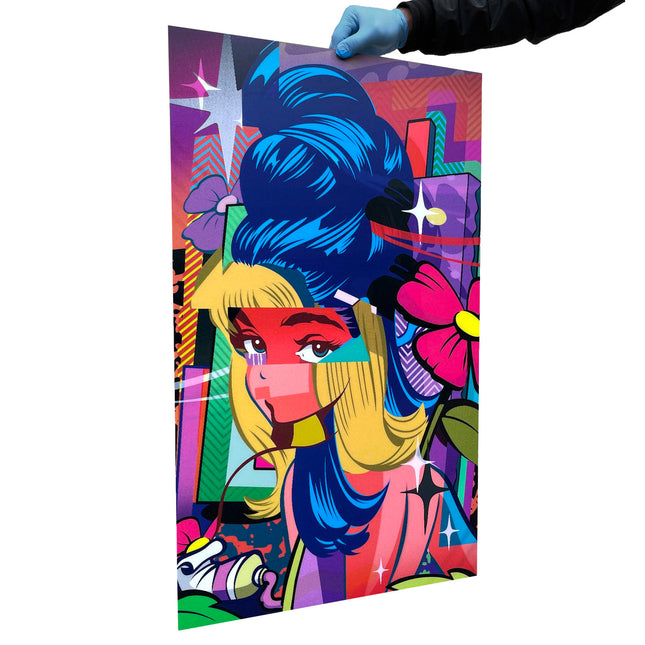
Pose- Jordan Nickel Dollie XL Lenticular Print by Pose- Jordan Nickel
Dollie XL Lenticular Print by Pose- Jordan Nickel Hand-Pulled 3 Phase Holographic Like Deckled Paper Limited Edition Artwork. 2021 Signed & Numbered Limited Edition of 50 Artwork Size 22.5x36 Lenticular Changing Print That Shifts Colors Across A Woman With Large Bee Hive Hair Cut. Pose, or Jordan Nickel, further establishes his position in the contemporary art world with his groundbreaking work titled "Dollie XL Lenticular". Evoking a sense of nostalgia while pioneering modern techniques, Pose demonstrates a mastery of pop and street art traditions, encapsulated within this transcendent artwork. Spanning a generous 22.5 x 36 inches, "Dollie XL Lenticular" is a limited masterpiece with only 50 pieces available, each bearing the signature of the artist, attesting to its authenticity. Crafted in 2021, the lenticular print technique employed offers a dynamic visual experience. Depending on the viewer's position, the optical colors shift, creating a mesmerizing, almost holographic effect. Central to this play of color and light is an arresting depiction of a woman characterized by her voluminous beehive hairstyle, an iconic symbol that has transcended time and resonates with pop culture aficionados. One of the standout features of this artwork is its deckled edges, which give the print a raw, tactile feel, further adding to its uniqueness. Accompanying each piece is a Certificate of Authenticity, a seal of the quality and genuineness of the work, ensuring collectors and art enthusiasts of their acquisition's value. In "Dollie XL Lenticular", Pose seamlessly blends historical motifs with innovative art techniques, crafting a piece that both pays homage to traditional pop and street art while signaling the future of these genres. The work stands as a testament to the enduring and evolving nature of visual expression, ever resonant and ever-evolving.
$2,347.00 $1,995.00
-
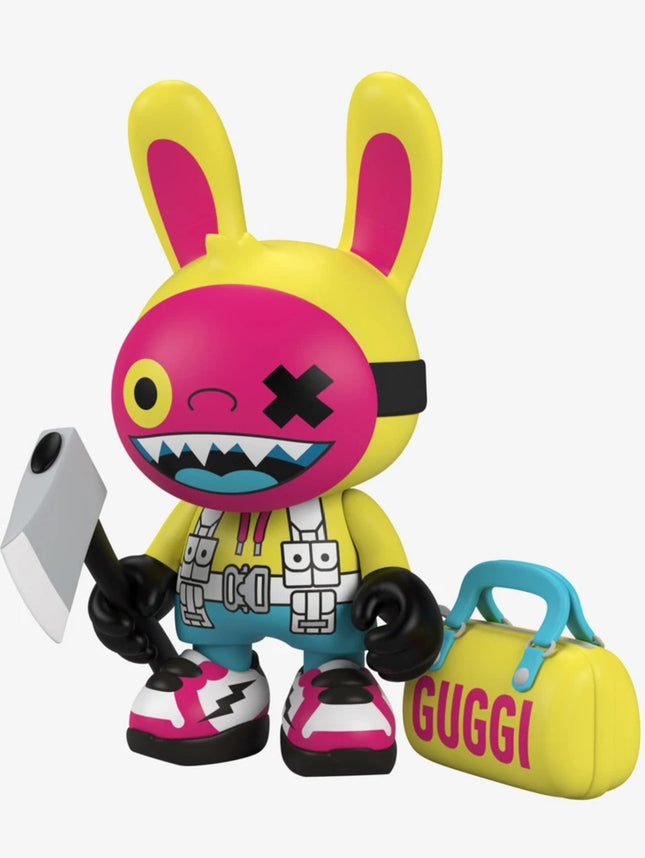
Guggimon Conceal N Bury Fashion EDC SuperGuggi Art Toy Guggimon x SuperPlastic
Conceal N Bury- Fashion EDC SuperGuggi Janky SuperPlastic Limited Edition Vinyl Artwork Street Art Toy Collectable Figure by Artist Guggimon. Limited Run Made In 2021 8' Tall. With iconic guggi mask, ax, and a bag full of lavender-scented lye, this 8” psycho is the perfect accomplice to any crime of fashion
$256.00
-
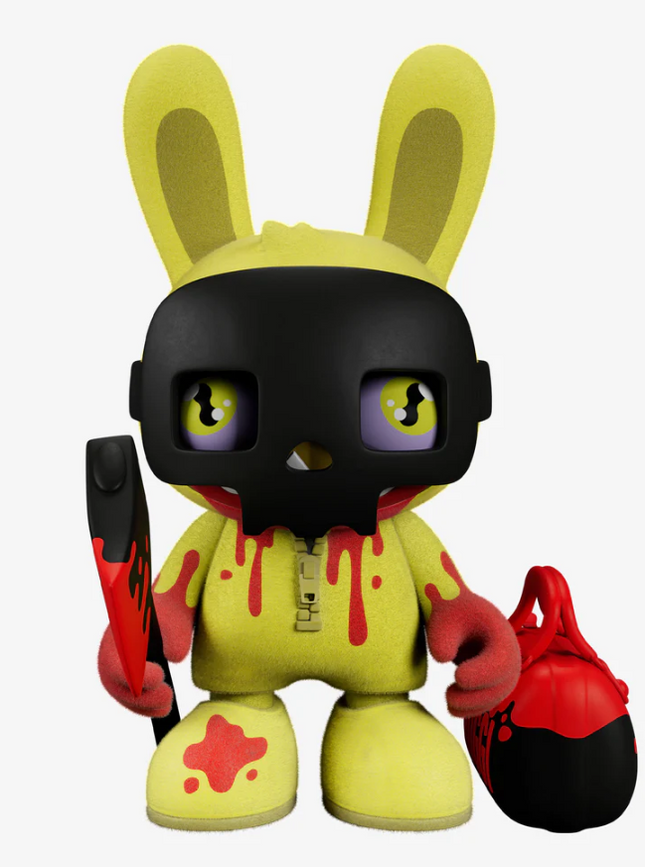
Guggimon Fashion Slumber Party Insomniac Surprise Slurp SuperGuggi SuperPlastic Art Toy by Guggimon
Fashion Slumber Party Insomniac Surprise Slurp SuperGuggi SuperPlastic Art Toy by Guggimon Limited Edition Janky Vinyl Art Toy Collectible Artwork by Modern Design Artist. 2022 Limited Run of 2000 SuperKranky Janky Superplastic Vinyl Art Toy Artwork Size 6x8
$215.00
-
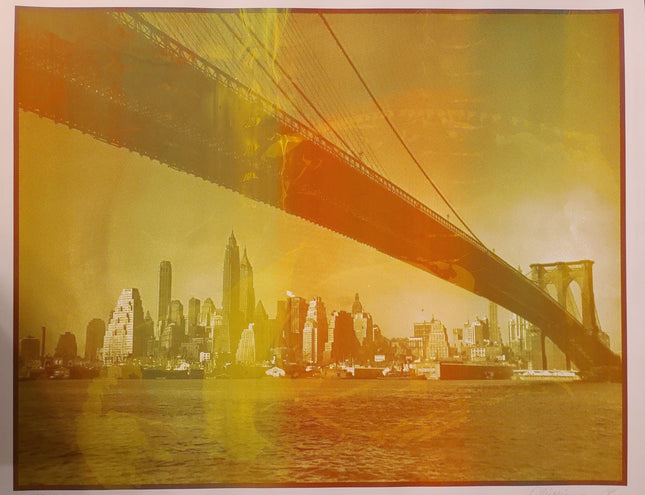
Tim Oliveira No Sleep Till Brooklyn #72 Yellow Green Silkscreen Print by Tim Oliveira
No Sleep Till Brooklyn- 72 Yellow Green 4-Color Mixed Edition Hand-Pulled Limited Edition Silkscreen Print on Fine Art Paper by Tim Oliveira Rare Street Art Famous Pop Artwork Artist. ME Mixed Edition Print, The Prints Vary In Color Through The Numbers of The Edition. 76 different silkscreen colors and variants in one edition. Signed and numbered, date stamped on back. The name of this print run has a double meaning to me. I decided to release it on August 5th to pay tribute to the Beastie Boys legend MCA (Adam Yauch); his birthday. Growing up, just about every day after school I would grab my basketball and head to the park or Boy's Club for some pickup games. Most of the time it was Beastie Boys on my walkman when I made the walk. They have always been a big influence on me. Also, no sleep till I feel confident with enough artwork for a solo show in Brooklyn. It may be a few years out, but I will keep trying to juggle family life, a regular job, and artwork with many late nights... -Tim Oliveira
$217.00
-
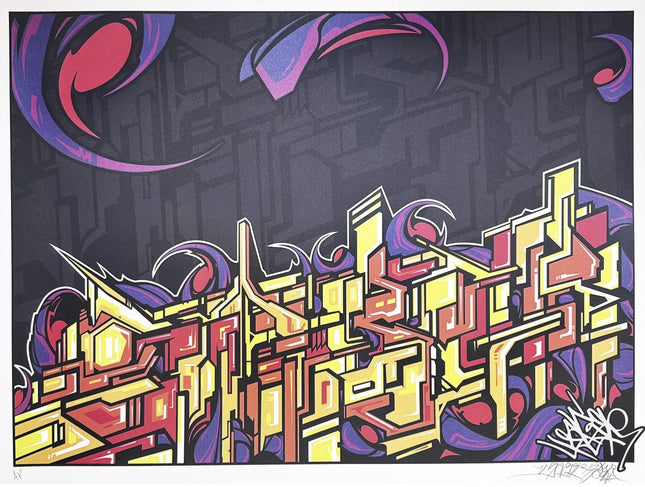
Saber Untitled Graffiti Future Throw-Up AP Giclee Print by Saber
Untitled Graffiti Future Throw-Up AP Artist Proof Pop Street Artwork Limited Edition Giclee Print on Fine Art Paper by Urban Graffiti Modern Artist Saber. AP Artist Proof 2009 Signed & Marked Regular Limited Edition of 100 Artwork Size 24x18 CAN'T REMEMBER THE NAME, 2009 Giclée Print 24 x 18 in (60.96 x 45.7 cm) Limited Edition of 100 Signed by the Artist w/ AP Notation
$861.00
-
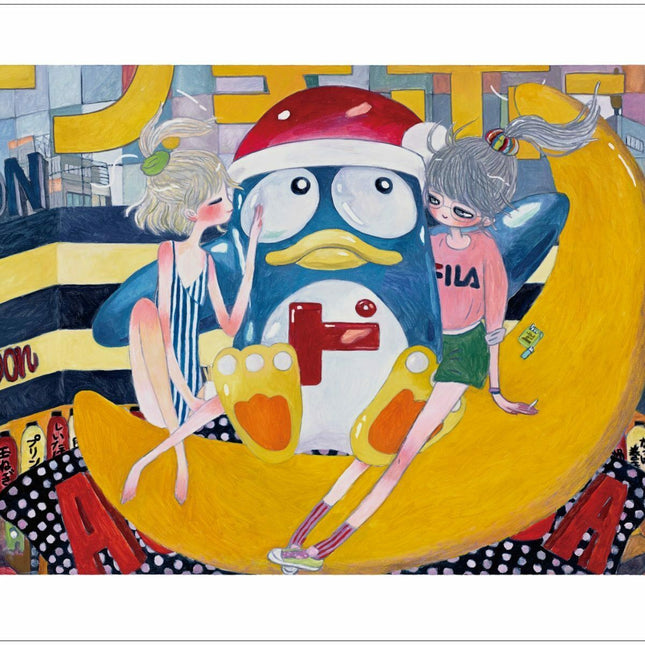
Aya Takano Dokidoki Donpen Archival Silkscreen Print by Aya Takano
Dokidoki Donpen Archival Pigment Print & 4-Color Hand-Pulled Limited Edition Silkscreen Print on Fine Art Paper by Aya Takano x TM/KK Rare Street Art Famous Pop Artwork Artist. 2020 Signed Archival Pigment Print + Silkscreen 14 4/5 × 18 9/10 in 37.6 × 48.1 cm Edition of 50 TM/KK
$2,916.00
-
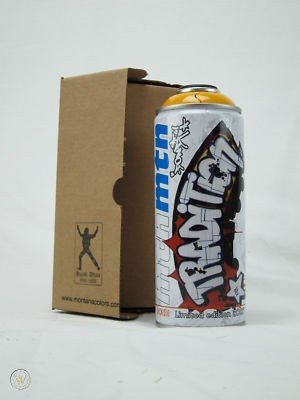
Dondi White Dondi Middle Yellow Spray Paint Can Artwork by Montana MTN
Dondi- Middle Yellow Limited Edition Rare Spray Paint Can Artwork Crossover by famous graffiti paint maker Montana MTN. Dondi White Foundation X Winery. This limited edition is special not only for the artist he represents but for the purpose to which he is directed. In this case, Boston's legendary store, Bodega, promotes a project with which to pay tribute to who was undoubtedly one of the fundamental writers to understand the history of graffiti: Dondi White, and with which to raise funds for Foundation, which has been helping AIDS-affected since 2003.
$218.00
-
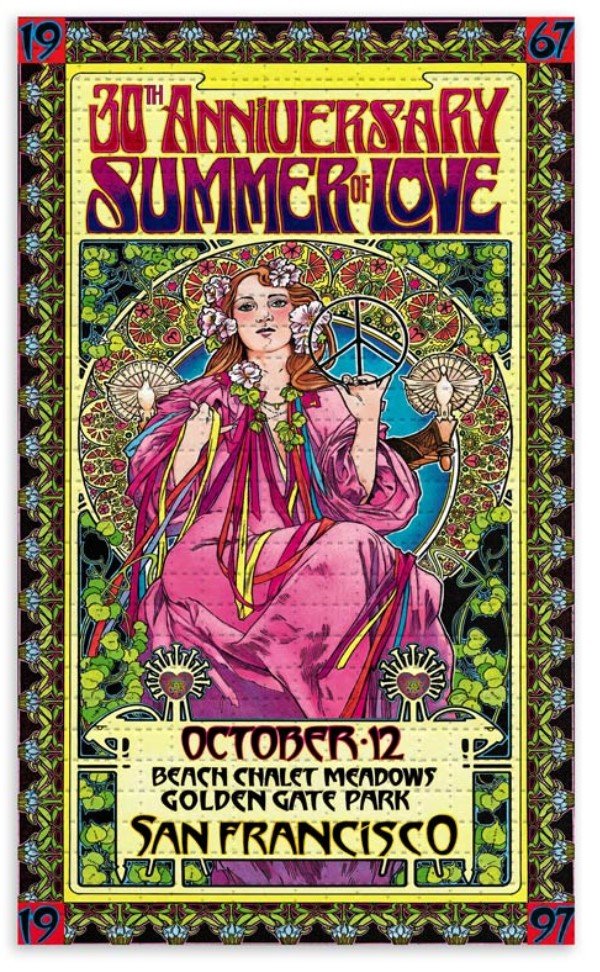
Bob Masse Summer of Love Full Blotter Paper Archival Print by Bob Masse
Summer of Love- Full Blotter Paper Limited Edition Archival Pigment Print Art on Perforated Blotter Paper by Bob Masse pop culture LSD artwork. Archival Pigment Print on Perforated Blotter Paper Size: 4.5 x 7.5 Inches Release: April 19, 2021 Limited blotter editions are hand-perforated by Zane Kesey & may vary slightly from the example shown.
$352.00
-
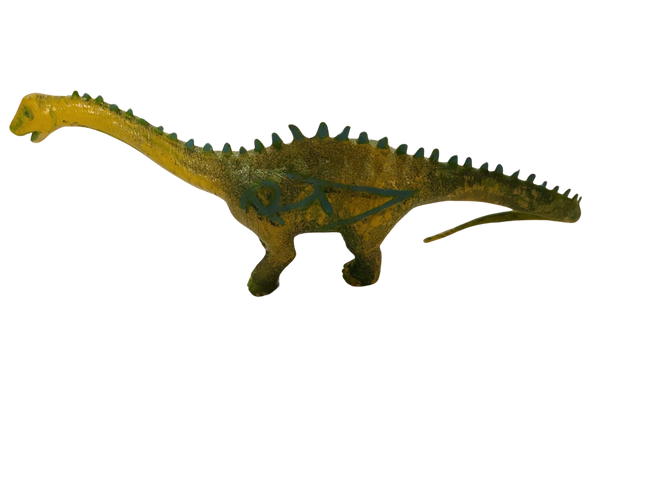
RD-357 Real Deal Graffiti Tagged Brachiosaurus Reclaimed Art Toy by RD-357 Real Deal
Graffiti Tagged Brachiosaurus Original Spray Paint & Acrylic on Plastic Dinosaur Sculpture Artwork by graffiti street artist modern pop artist RD-357. 2012 RD-357 Graffiti Spray Paint & Acrylic on Reclaimed/Upcycled (RD-357's Child's) Dinosaur Artwork Signed 9.5x3 The Innovative Fusion of Street Pop Art and Play: RD-357's Graffiti Tagged Brachiosaurus RD-357, a modern graffiti street artist, has been known for his innovative approach to street pop art and graffiti artwork, blurring the lines between traditional street art mediums and everyday objects. In 2012, RD-357 embarked on a project that would further cement his reputation as a pioneer in the field, taking on the challenge of transforming a plastic dinosaur sculpture into a piece of contemporary art. The result was the "Graffiti Tagged Brachiosaurus," a unique synthesis of playful nostalgia and the gritty aesthetic of street art, encapsulating the essence of RD-357's creative vision. This artwork is a striking example of how RD-357 repurposes and reimagines found objects, such as a reclaimed toy from his child's collection, and imbues them with new life through street art. Once a simple plastic figure, the Brachiosaurus stands redefined by the bold graffiti tags and vibrant splashes of spray paint and acrylic. At 9.5x3 inches, the sculpture is modest in size but grand in its artistic statement, signed by the artist himself, serving as a hallmark of authenticity and a personal touch from the artist's own life. RD-357's Artistic Process: Marrying Childhood Innocence with Street-Savvy Creating the "Graffiti Tagged Brachiosaurus" involved a meticulous application of spray paint and acrylic, techniques well-versed in the graffiti art scene. RD-357 has taken the familiar form of the Brachiosaurus and layered it with complex patterns and symbols that are intrinsic to the visual language of street pop art. The dinosaur's textured skin becomes a canvas for a dynamic interplay of colors and shapes, with each tag and stroke of paint adding to the narrative that RD-357 constructs. This narrative is one of juxtaposition - the innocence of a child's toy contrasted against graffiti's edgy and often transgressive nature. The Brachiosaurus, a creature from a bygone era, is recontextualized through RD-357's art as a contemporary cultural artifact. By taking an object associated with the past and childhood and merging it with the modern urban art form of graffiti, RD-357 makes a statement about the enduring nature of art, creativity, and expression. The graffiti tags are not just markings; they are the artist's language, speaking to themes of transformation, reinvention, and reclaiming spaces and objects for art. Legacy and Influence: RD-357's Contribution to Street Pop Art The "Graffiti Tagged Brachiosaurus" is not merely an artwork; it is a testament to RD-357's innovative spirit and ability to see the potential for art in the unlikeliest places. It symbolizes street pop art's versatility and boundless nature, where any surface can become a masterpiece, and any object can tell a story. RD-357's work challenges the viewer to see beyond the conventional and to appreciate the beauty and complexity that can arise when street art intersects with the objects of our everyday lives. RD-357's contribution to street pop art and graffiti artwork is significant, as he consistently pushes the envelope with each project he undertakes. The Brachiosaurus, once a simple figure meant for play, now carries the weight of artistic innovation and cultural commentary, thanks to the artist's vision and skill. RD-357's artworks, particularly this unique sculpture, resonate with a broad audience, from art collectors to street culture enthusiasts, and inspire new approaches to street pop art. Through the "Graffiti Tagged Brachiosaurus," RD-357 expands the dialogue around what constitutes a canvas and where art can exist. His bold transformation of a plastic toy into a piece of street pop art showcases his talent and invites us to reconsider our perceptions of play, art, and the spaces in between. The sculpture is a vibrant example of the potential for street art to transcend traditional boundaries and enter into new realms of creative expression.
$309.00
-
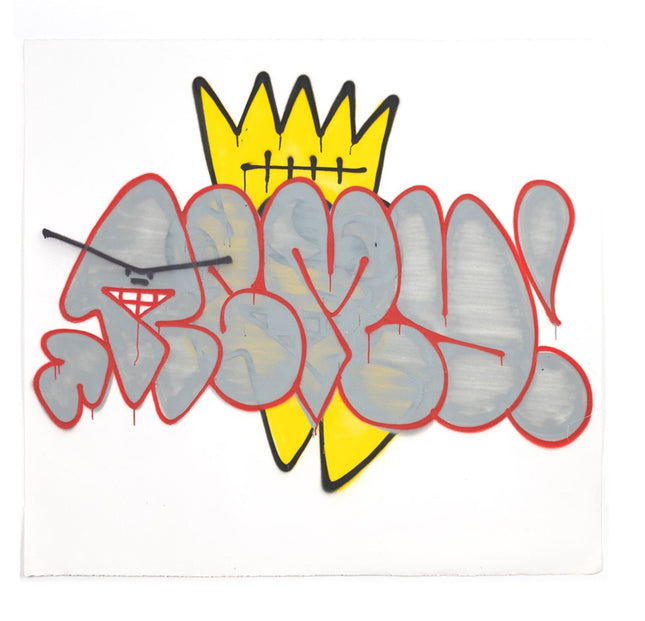
Remio Remio Study 04 Original Acrylic Spray Paint Painting by Remio
Remio Study- 04 Original One of a Kind Mixed-Media Spray Paint, Acrylic Painting Artwork on Fine Art Paper by Popular Street Graffiti Artist Remio. Mixed Media on Fine Art Paper Size: 54 x 50 Inches Release: January 31, 2020 Run of: 1 Massive
$2,933.00 $2,493.00
-
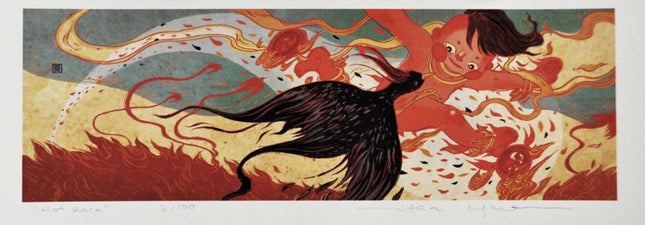
Victo Ngai The Hot Race Giclee Print by Victo Ngai
The Hot Race Artwork Giclee Limited Edition Fine Art Print on 100% Cotton Hahnemühle Museum Etching Paper by Pop Culture Graffiti Artist Victo Ngai. Limited edition of 100. Signed and numbered. Due to how this artwork was made and stored by the artist, many of Ngai's older prints contain slight yellowing to the extreme upper and lower white margin that extends about 1mm. This does not effect the image at all and the prints are perfect besides this.
$262.00
-
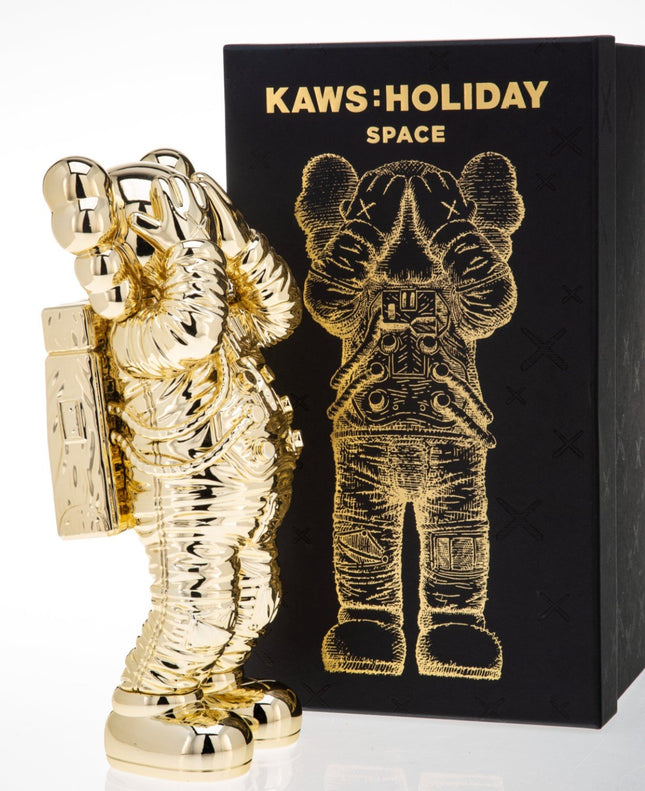
Kaws- Brian Donnelly Holiday Space- Gold Fine Art Toy by Kaws- Brian Donnelly
Holiday Space- Gold Limited Edition Vinyl Art Toy Collectible Artwork by Modern Pop Artist Kaws. 2020 Limited Open Edition 11.5 X 5 X 4.5 IN / 29.2 X 12.7 X 11.4 CM EACH Displayed With Box KAWS' Holiday Space-Gold: A Gleaming Fusion of Art and Adventure The Holiday Space-Gold figure by KAWS is a testament to the dynamic fusion of street art's accessibility and the aspirational realms of space exploration. As a 2020 limited open edition, this vinyl art toy stands at 11.5 x 5 x 4.5 inches and is displayed with a box that mirrors the figure's aesthetic. This piece transcends its material existence as a collectible to become a narrative of ambition after being sent over 135,000 feet above the earth, tied to a weather balloon, before returning to solid ground. The gold finish of the figure, each piece shimmering with a mirrored surface, captures the essence of the iconic MTV Moonman Trophy, which KAWS reimagined for the 2013 MTV VMAs. This connection to pop culture, paired with the figure's celestial voyage, encapsulates the essence of modern pop art—bold, boundary-pushing, and deeply intertwined with contemporary iconography. The release of these figures on the DDT Store website on August 17th, 2020, was a landmark event celebrating KAWS' innovative spirit within the context of Street Pop Art and graffiti Artwork. The Interstellar Journey of KAWS' Art in Public Perception The KAWS Holiday Space-Gold figure is not merely a physical object but a piece of performance art that challenged the limits of where art could go—quite literally. By launching the figure into the stratosphere, KAWS made a powerful statement about the boundless possibilities of artistic expression. Sending the figure into space before its release imbued it with a storied past and a triumphant return, reminiscent of the narratives of space travel and exploration that have captivated humanity for generations. In the context of street art and pop culture, the Holiday Space-Gold figure stands as a beacon of innovation. KAWS' collaboration with All Rights Reserved to achieve this feat exemplifies a collaborative spirit that drives much of street art's ethos, a willingness to embrace new methods, technologies, and partnerships to create something truly unprecedented. The figure's gold coloration is not only visually striking but also symbolically rich, often associated with achievement, triumph, and the extraordinary—themes that are deeply resonant with KAWS' overarching artistic narrative. KAWS' Holiday Space-Gold as a Modern Artefact As a sold-out limited edition, the Holiday Space-Gold figure by KAWS has secured its place as a modern artifact within collectible art. Its historic journey into space and back, coupled with its allusion to the MTV Moonman, renders it a complex symbol of contemporary culture's fascination with spectacle, celebrity, and the cosmic unknown. The figure's reflective surface interacts with its environment by capturing light and space and invites introspection about the viewer's place in the universe and within the narrative of street art. As street pop art and graffiti artwork continue to assert their relevance in the fine art world, KAWS' Holiday Space-Gold figure serves as a reminder of the genre's ever-expanding horizon. It is a statement piece that conveys the artist's vision of pushing the boundaries of what art can be and where it can go. With its rich backstory and striking presence, this figure encapsulates the adventurous spirit of KAWS' work and the ongoing evolution of street art into new and unexpected territories.
$2,430.00
-
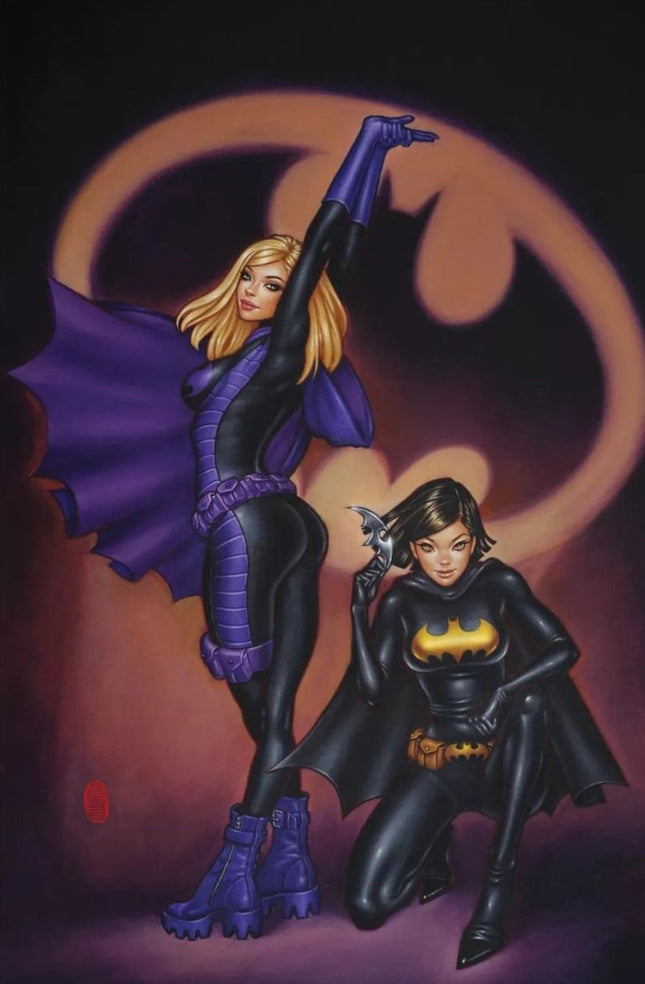
Mimi Yoon Batgirls Giclee Print by Mimi Yoon
Batgirls Artwork Giclee Limited Edition Print on Fine Art Paper by Pop Culture Graffiti Artist Mimi Yoon. 18x25 Series of 100 2021 DC Comics Batgirl by Mimi Yoon
$323.00
-
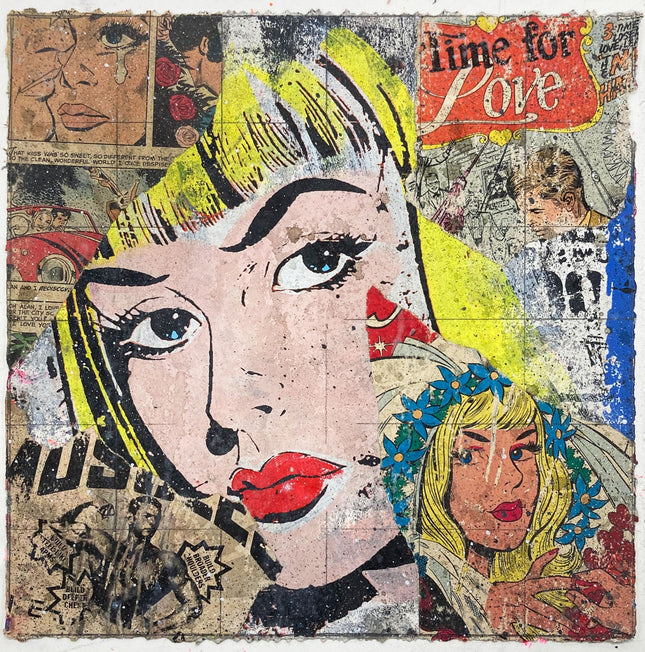
Greg Gossel Secret Romance 13 HPM Silkscreen Print by Greg Gossel
Secret Romance 13 HPM One of a Kind Mixed Media Silkscreen, Acrylic, Collage & Spray Paint Painting Artwork on Fine Art Paper by Pop Modern Artist Greg Gossel. 2022 Signed & Numbered HPM Limited Edition of 15 Embleshed Artwork Size 12x12 Mixed Media Silkscreen One-of-a-Kind HPM Artwork Edition of 15 Unique Pieces
$503.00
-
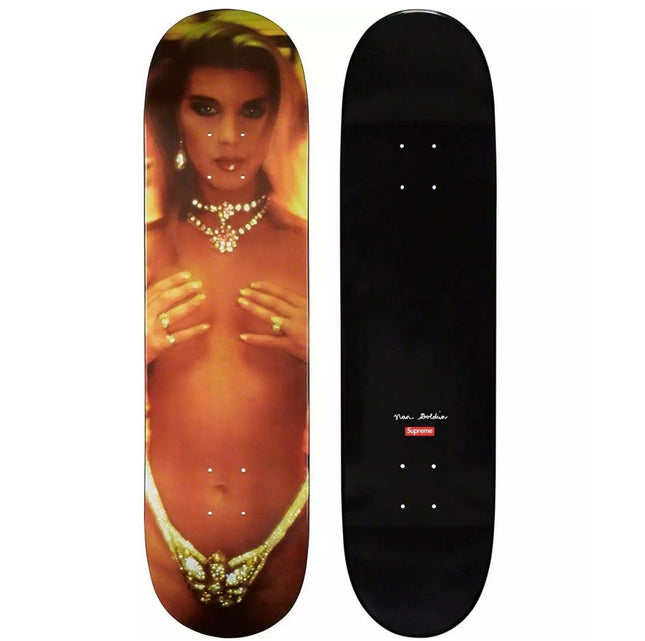
Supreme Nan Goldin Kim In Rhinestones Skateboard Art Deck by Supreme
Supreme Nan Goldin Kim Deck In Rhinestones Limited Edition Skateboard deck art by Designer Brand Supreme SS18 2018 As part of their Spring/Summer 2018 collection, Supreme worked with renowned American photographer Nan Goldin for a collaboration. These skate decks featured Goldin's classic photography. This particular deck, titled "Kim in Rhinestones" showcases Goldin's signature portrait style photography with vibrant colors and details.
$233.00
-

Cleon Peterson The Return Black & Gold Silkscreen Print by Cleon Peterson
The Return Black & Gold Silkscreen Print by Cleon Peterson on Hand Deckled 290gsm Coventry Rag Fine Art Paper Limited Edition Artwork. 2025 Signed & Numbered Cleon Peterson Limited Edition of TBD Artwork Size 20x20 Silkscreen Print of a Warrior Man on Horse with Bloody Sword. Released During January 2025, California Fires. The Return Black & Gold Silkscreen Print: A Stark Narrative by Cleon Peterson The Return by Cleon Peterson is a striking example of Street Pop Art and Graffiti Artwork, blending minimalist design with profound storytelling. This limited-edition silkscreen print, released in January 2025, is created on hand-deckled 290gsm Coventry Rag fine art paper, offering both visual and tactile depth. Measuring 20x20 inches, it features Peterson's signature style, characterized by bold contrasts and graphic figures. Depicting a warrior astride a horse, wielding a bloody sword, the artwork presents themes of conflict, dominance, and survival. Released during the California fires of 2025, the piece resonates with an atmosphere of destruction and resilience, drawing parallels between personal battles and larger societal struggles. Cleon Peterson’s Distinctive Artistic Voice Cleon Peterson is known for his stark, graphic style that combines elements of pop art with the intensity of graffiti-inspired aesthetics. His work often explores themes of power dynamics, chaos, and human nature's darker facets. The Return continues this tradition, with the central figure of a warrior on horseback symbolizing conquest and survival. The use of black and gold adds a regal yet ominous tone, heightening the tension in the scene. Peterson’s ability to distill complex narratives into simplified forms creates an immediate visual impact while inviting deeper reflection on the themes presented. Design and Symbolism in The Return The Return features a dramatic composition where the central warrior figure dominates the visual space. The horse, rendered in Peterson’s signature minimalism, evokes movement and strength, while the bloody sword serves as a stark reminder of violence and its consequences. The black background amplifies the figure's golden hue, emphasizing its prominence and isolating it in a void-like space. This duality of light and dark symbolizes not just conflict but also resilience and survival. The stripped-down aesthetic reflects the rawness of struggle, making the piece both visually striking and thematically intense. Limited Edition Craftsmanship and Context Printed on premium Coventry Rag fine art paper, The Return is hand-deckled to give it an artisanal quality that complements the graphic intensity of the artwork. Signed and numbered by Cleon Peterson, the limited-edition nature of the piece ensures its exclusivity and collectibility. The timing of its release during the California fires adds an additional layer of relevance, tying the themes of destruction and survival to contemporary events. The Return exemplifies the intersection of Street Pop Art and Graffiti Artwork, capturing both the raw energy of street art and the enduring narratives of human conflict and resilience. This piece stands as a testament to Peterson’s mastery in merging minimalist design with powerful storytelling.
$400.00
-
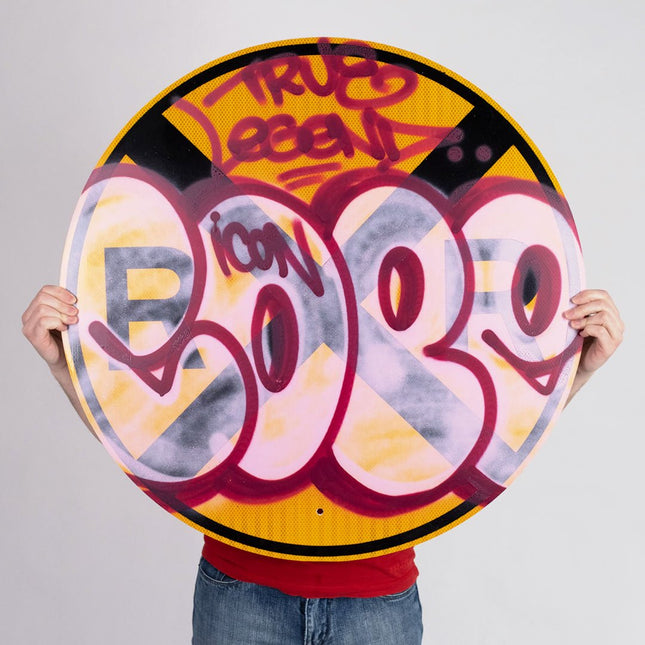
Cope2- Fernando Carlo RR Crossing True Legend Original Street Sign Graffiti Painting by Cope2- Fernando Carlo
RR Crossing- True Legend Original Mixed Media Painting graffiti artist modern pop art on Real Metal Street Sign by Cope2. Paint on Street Sign Size: 30 x 30 Inches Release: March 24, 2021 Run of: 1 During the mid-1990s Cope2 started slowly transitioning from the streets to the art scene of the galleries. At that time, street art was not as popular as it is in our days and the general public’s idea of it was still inextricably connected to ghettos, drug dealing, etc. The artist has never hidden his troubling past and avoids idealizing it, as a way to enhance his career and artistic persona. On the contrary, he mentions the following: “Oh man, there’s nothing to be proud of in hustling, but I had my first child at the age of 16, my son. So I had to make money to support him and his mother.
$2,607.00 $2,216.00
-
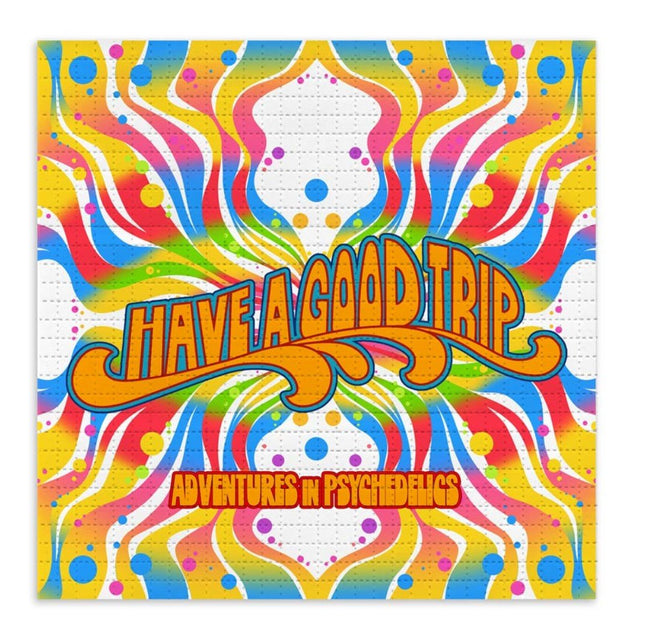
Have A Good Trip Adventures in Psychedelics II Blotter Paper Archival Print by Have A Good Trip
Adventures in Psychedelics II Blotter Paper Limited Edition Archival Pigment Print Art on Perforated Blotter Paper by Have A Good Trip pop culture LSD artwork. Archival Pigment Print on Perforated Blotter Paper Size: 7.5 x 7.5 Inches Release: April 19, 2021 Limited blotter editions are hand-perforated by Zane Kesey & may vary slightly from the example shown.
$352.00
-

Ben Frost Pearl Jam Nov 18th Melbourne Gig Poster Silkscreen Print by Ben Frost
Pearl Jam Nov 18th Melbourne Gig Poster Silkscreen Print by Ben Frost Hand-Pulled on Fine Art Paper Limited Edition 6 Color Screenprint Artwork. 2024 Signed & Numbered Limited Edition of 100 Artwork Size 24x18 Silkscreen Print Official Pearl Jam Holographic Sticker on Back. Pearl Jam, Pixies & Teen Jesus and the Jean Teasers, Marvel Stadium, Melbourne, Australia. Pearl Jam Melbourne Gig Poster by Ben Frost The Pearl Jam November 18th 2024 Melbourne gig poster by Ben Frost is a striking silkscreen print that merges the visual voltage of contemporary Street Pop Art & Graffiti Artwork with the live energy of one of rock’s most iconic bands. This officially licensed concert print commemorates Pearl Jam’s appearance at Marvel Stadium in Melbourne, joined by legendary alternative rock band Pixies and rising Australian act Teen Jesus and the Jean Teasers. Hand-pulled on fine art paper using six vibrant colors, this limited edition print is signed and numbered by Ben Frost and comes with an official Pearl Jam holographic sticker affixed to the back, affirming its authenticity. Visual Energy and Symbolism The artwork presents an explosive mirrored composition featuring two yellow cockatoos—native to Australia—locked in a bold and symmetrical confrontation. Their wings are ablaze with flames, rendered in a high-contrast palette of crimson, amber, and electric yellow. The birds’ feathers pulse with intensity, each form carefully delineated through Frost’s precise graphic technique. Their talons meet at the center, interlocking to form a clenched gesture that suggests solidarity, power, and resistance. Between the wings, flames rise upward, forming the spiritual and literal heat of the print—mirroring the fire and urgency that has always defined Pearl Jam’s music. Emblazoned on one wing is the date of the concert, NOV 18 2024, while the other wing marks the venue: MARVEL STADIUM MELBOURNE. The typography is seamlessly integrated into the design, serving both function and form, rooted in graffiti styling but refined through the lens of fine art silkscreen work. Artist Background and Street Pop Context Ben Frost is an internationally recognized Australian artist known for his ability to appropriate pop culture, pharmaceuticals, corporate logos, and advertising language into subversive and often satirical compositions. Through his Street Pop Art & Graffiti Artwork, Frost explores consumer culture, identity, and rebellion. This poster carries those same hallmarks of his wider body of work—exaggerated color palettes, clean linework, and a dense sense of visual stimulation. While Frost is renowned for his critiques of media saturation and capitalist spectacle, this piece celebrates a specific cultural moment. The visual style reflects his skill at mixing commercial and countercultural influences into something both collectible and critical, blending the immediacy of street art with the polish of screenprinted fine art editions. Concert Culture and Contemporary Collectibles As with all official Pearl Jam gig posters, this print serves as a functional keepsake but transcends into the realm of visual art. At 24x18 inches, the scale is significant, ideal for collectors and fans who appreciate not just the music but the iconography it inspires. Limited to only 100 hand-signed and numbered prints, it represents an exclusive collaboration between music and visual art communities. Pearl Jam has consistently aligned themselves with socially conscious and artistically progressive projects, and their ongoing partnership with artists like Ben Frost reinforces their legacy. With added support from the Pixies and Teen Jesus and the Jean Teasers on this tour stop, the print also captures a cross-generational exchange within alternative music. Ben Frost’s poster is more than promotional material—it is a symbolic totem of sound, culture, and resistance, crystallized through the fire of silkscreen artistry.
$380.00
-
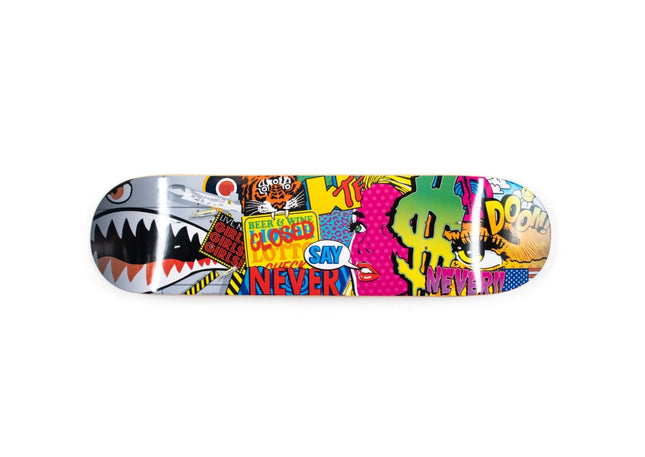
Denial- Daniel Bombardier Never Say Never Deck Skateboard Deck by Denial- Daniel Bombardier
Never Say Never Deck Fine Art Limited Edition Archival Pigment Print Transfer on Cold Pressed Steep Natural Skateboard Deck by Street Artwork Graffiti Artist Denial. 2021 Limited Edition of 35 Archival Pigment Print Transfer on Cold Pressed Steep Natural Skate Deck Size: 8 x 31.875 Inches Release: July 14, 2021 Run of: 35 Denial’s art is strongly political and social since the artist takes specific positions against issues, such as capitalism, consumer culture, and advertisements. More importantly, the artist is aware of his choices and motivations: “I like to think of myself as activist pop art. How I relate with cartoons and graphics is a lot easier than I do with photo-realistic stuff" Another aspect of Denial's work is humor. His work is satirical, which, by definition, means that it uses humor as a confronting mechanism.
$466.00
-
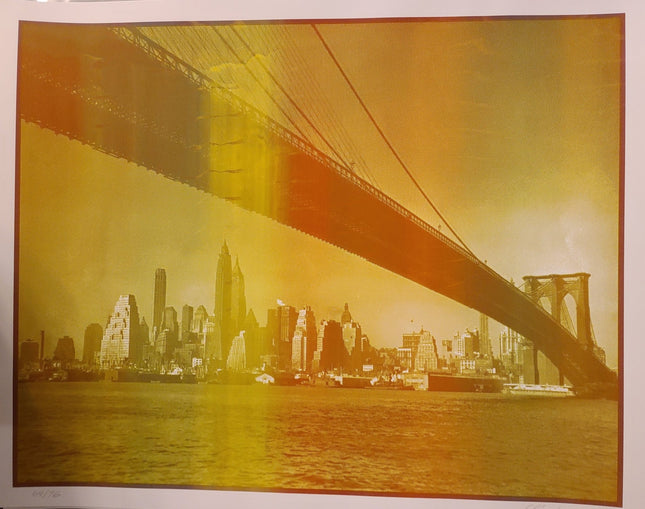
Tim Oliveira No Sleep Till Brooklyn #64 Yellow Green Silkscreen Print by Tim Oliveira
No Sleep Till Brooklyn 64- Yellow Green 4-Color Mixed Edition Hand-Pulled Limited Edition Silkscreen Print on Fine Art Paper by Tim Oliveira Rare Street Art Famous Pop Artwork Artist. ME Mixed Edition Print, The Prints Vary In Color Through The Numbers of The Edition. 76 different silkscreen colors and variants in one edition. Signed and numbered, date stamped on back. The name of this print run has a double meaning to me. I decided to release it on August 5th to pay tribute to the Beastie Boys legend MCA (Adam Yauch); his birthday. Growing up, just about every day after school I would grab my basketball and head to the park or Boy's Club for some pickup games. Most of the time it was Beastie Boys on my walkman when I made the walk. They have always been a big influence on me. Also, no sleep till I feel confident with enough artwork for a solo show in Brooklyn. It may be a few years out, but I will keep trying to juggle family life, a regular job, and artwork with many late nights... -Tim Oliveira
$217.00
-
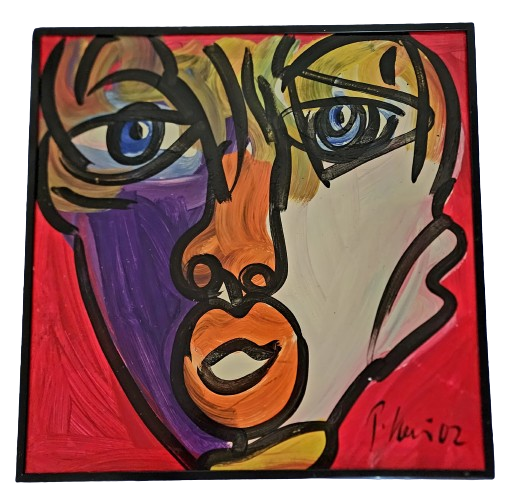
Peter Keil Warhol 02 Red Purple Original Oil Painting by Peter Keil
Warhol 02 Red Purple Original Oil Painting by Peter Keil One of a Kind Artwork on Masonite Panel by The Wild Man of Berlin, a Famous Contemporary Artist. 2002 Signed by Peter Keil & Dated Oil Painting on Masonite Panel Original Artwork Size 24x24. All of Peter Keil's Art Used Thick Paint & Some Paint Flaking May Be Present Due to the Age and Nature of His Work. Painting of Andy Warhol Friend Face Pruple Red & White. Intense Expressionism in Peter Keil's Warhol 02 Red Purple The "Warhol 02 Red Purple Original Oil Painting" by Peter Keil, also known as The Wild Man of Berlin, is a captivating exploration of form and color through the lens of Neo-Expressionism. This one-of-a-kind artwork on a Masonite panel embodies the spirited energy of the artist, a famous contemporary figure known for his daring use of colors and profound representation of faces. The 2002 piece, signed and stamped with the year by Keil, is a square of emotion measuring 24x24 inches, where the thick application of paint forms an image of Andy Warhol, revealing the profound influence of pop art on Keil's work. Keil's artistic method is defined by a bold, impasto technique where the paint is layered on thickly, giving the artwork a three-dimensional texture that is both seen and felt. This technique results in some degree of flaking over time, which is considered an inherent characteristic of Keil's work, adding to its authenticity and historical value. The "Warhol 02 Red Purple" painting is a testament to this style, with its vibrant reds and deep purples merging to form the iconic visage of Warhol, set against a stark white background. Peter Keil's Contribution to Contemporary Art Peter Keil's contribution to street pop art and graffiti artwork is substantial, as he brings street art's raw, untamed essence into the gallery. His work eschews the conventional polish and restraint often associated with fine art, instead embracing a wild abandon more commonly found on the streets and in the alleys where graffiti thrives. The "Warhol 02 Red Purple" vividly illustrates this philosophy, with the painting's subject – a pop art pioneer – being depicted in Keil's uninhibited style, creating a bridge between the two artistic worlds. Each of Keil's paintings is an original narrative, a story told in the visual language of colors and shapes. Collectors and enthusiasts of Keil's work are attracted to his paintings' intense emotion and distinctive style. In the case of "Warhol 02 Red Purple," the allure is enhanced by the subject matter – the legendary Andy Warhol – which positions the painting at the intersection of pop art heritage and contemporary artistic innovation. Owning a piece by Peter Keil is more than an acquisition of art; it is an immersion into the vibrant life story of the painting itself. The flaking paint, the bold strokes, and the striking contrasts create an experience that is as evocative and complex as the artist himself. The "Warhol 02 Red Purple" is a vibrant symbol of Keil's enduring artistic vision and impact on the art world. The "Warhol 02 Red Purple Original Oil Painting" by Peter Keil is a visual feast and an essential piece of contemporary art history. This work encapsulates the essence of street pop art and graffiti through the lens of a master painter whose unorthodox approach to art has captured the attention of the global art community. Keil's painting celebrates expressive freedom and the power of art to convey profound human emotion and thought.
$676.00
-

Ben Frost Goofy Love- Red Silkscreen Print by Ben Frost
Goofy Love- Red 5-Color Hand-Pulled Limited Edition Silkscreen Print on Hand Deckled Mohawk Superfine UltraWhite Paper by Ben Frost Rare Street Art Famous Pop Artwork Artist. Signed Goofy Love, 2016 - Red Variant 5-colour, hand-pulled Screen Print featuring two-colour split fountain Printed on Mohawk Superfine UltraWhite, 160lb cover with deckled edges 20 x 24” / 51 x 61 cm Edition of 50, Signed and numbered by Ben Frost Printed by POP!NK Editions Goofy Love - Red Variant by Ben Frost: A Bold Icon of Street Pop Art & Graffiti Artwork Goofy Love - Red Variant is a striking piece of Street Pop Art & Graffiti Artwork created by Australian artist Ben Frost, an artist internationally recognized for his provocative blend of pop culture imagery and consumer critique. Released in 2016, this rare artwork is a five-color hand-pulled silkscreen print featuring a two-color split fountain technique, adding a vivid depth and richness to the composition. Printed on Mohawk Superfine UltraWhite 160lb cover stock with hand-deckled edges, the piece measures 20 x 24 inches or 51 x 61 centimeters. The edition was limited to just 50 pieces, each signed and numbered by Ben Frost, and produced by the renowned POPINK Editions. This work features the beloved Disney character Goofy, yet Frost subverts the traditional innocence by depicting blood-soaked hands spelling out the word LOVE, offering a visceral commentary on the dualities within affection and violence. The Artistic Method and Power Behind Goofy Love - Red Variant Ben Frost’s use of a five-color silkscreen process brings a sharp, dynamic intensity to Goofy Love - Red Variant. The two-color split fountain technique adds a mesmerizing gradient effect, enhancing the sense of movement and emotional turmoil conveyed through the image. By employing Mohawk Superfine UltraWhite paper with deckled edges, Frost ensures that the tactile quality of the piece matches its visual impact, further emphasizing its handmade authenticity. Goofy, typically seen as a symbol of bumbling innocence, becomes a vehicle for darker commentary under Frost’s interpretation. His wide, almost panicked eyes and blood-streaked hands draw viewers into a conversation about the hidden ferocity behind ideas of love and devotion. This artwork challenges the consumer-friendly portrayals of love and reveals the messy, often violent realities that can lurk beneath surface-level emotions, a central theme within Street Pop Art & Graffiti Artwork. Ben Frost’s Revolutionary Approach to Street Pop Art & Graffiti Artwork Ben Frost, born in Australia, has carved a unique space within the Street Pop Art & Graffiti Artwork world by consistently blending the familiar with the provocative. His work frequently involves appropriating and recontextualizing corporate logos, cartoon characters, and pharmaceutical packaging to critique modern consumerism and societal norms. In Goofy Love - Red Variant, Frost successfully transforms a globally beloved figure into a symbol of unsettling human truths. His ability to juxtapose playfulness with violence exemplifies the subversive potential of Street Pop Art & Graffiti Artwork, a style that thrives on challenging established narratives and provoking raw emotional responses from viewers. Frost’s mastery of screen printing techniques combined with his fearless thematic choices solidify his reputation as one of the leading contemporary voices in this field. The Collectibility and Cultural Impact of Goofy Love - Red Variant The rarity and craftsmanship of Goofy Love - Red Variant make it a coveted piece among collectors and enthusiasts of Street Pop Art & Graffiti Artwork. With only 50 prints in existence, each hand-signed and numbered by Ben Frost, the artwork captures a moment where traditional pop imagery is transformed into a powerful critique of contemporary emotional landscapes. The choice of Mohawk Superfine UltraWhite paper and the meticulous hand-deckled edges elevate the piece beyond a simple print into the realm of fine art. Printed by POPINK Editions, a studio known for producing high-quality screen prints for leading artists, this work stands as a significant contribution to the evolution of Street Pop Art & Graffiti Artwork. Goofy Love - Red Variant forces viewers to confront the contradictions of love, violence, and commodification in a way that only a master of pop cultural subversion like Ben Frost could achieve.
$3,500.00
-
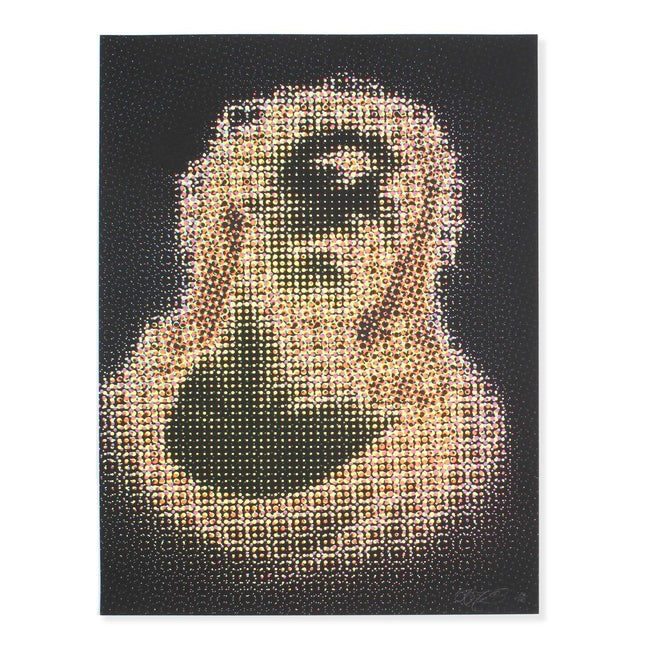
SSUR- Ruslan Karablin Halftone Jesus Black Silkscreen Print by SSUR- Ruslan Karablin
Halftone Jesus- Black 5-Color Hand-Pulled Limited Edition Silkscreen Print on Fine Art Paper by SSUR- Ruslan Karablin Rare Street Art Famous Pop Artwork Artist.
$533.00
-
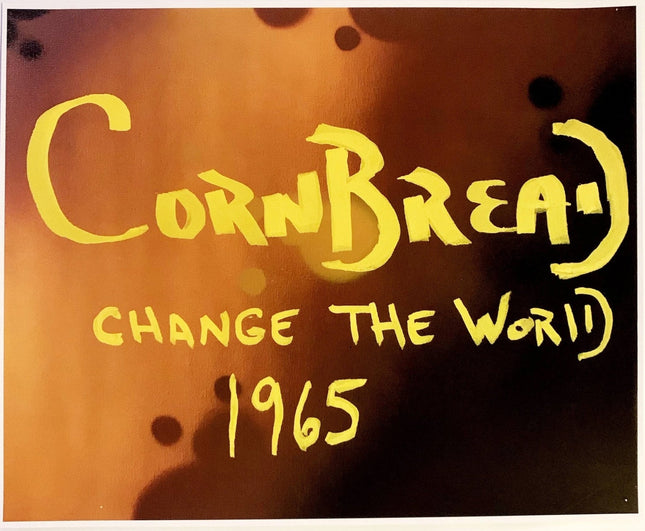
Cornbread- Darryl McCray Changed The World Archival Print by Cornbread- Darryl McCray
Changed The World Archival Pigment Fine Art Limited Edition Print on Fine Art Paper by Modern Pop Street Graffiti Artist Cornbread- Darryl McCray. 2021 Cornbread The Legend (Blue Yellow) 24" x 12.5" (Inches) Limited Edition Print: Archival Pigment Print Paper: Fine Art Paper Size: 24" x 12.5" (Inches) Edition Size -10 Hand-signed & Numbered by Artist
$217.00
-
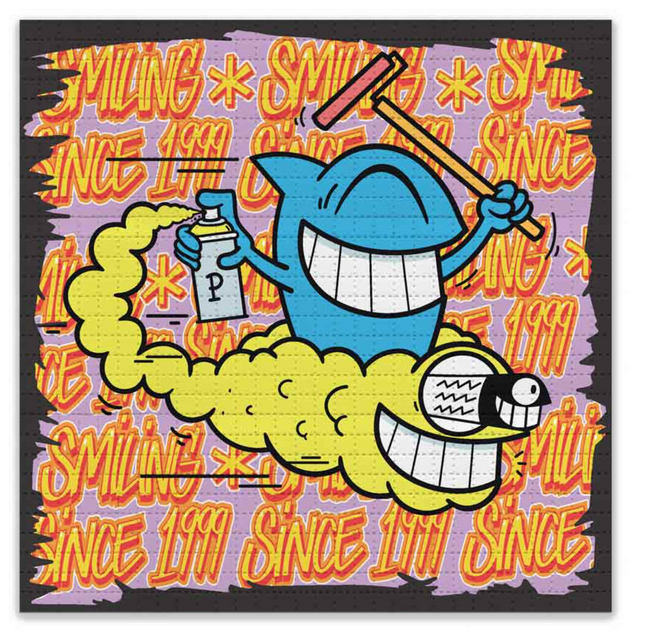
El Pez Spraying Clouds Blotter Paper Archival Print by El Pez
Spraying Clouds Blotter Paper Archival Print by El Pez Limited Edition Fine Art Archival Pigment Print Art on Perforated Blotter Paper. 2023 Signed & Numbered Limited Edition of 35 Archival Pigment Print on Perforated Blotter Paper Size: 7.5 x 7.5 Inches Release: April 19, 2023 Limited blotter editions are hand-perforated by Zane Kesey. Blotter paper artwork prints are a unique form of art that involves transferring ink onto specially treated blotter paper. The resulting prints are often abstract and colorful, and can be used for a variety of decorative and artistic purposes. To create a blotter paper artwork print, the artist first prepares the blotter paper by treating it with chemicals that will enhance its absorbency and ability to hold ink or dye. Then, ink or dye is applied to the paper using various techniques, such as dripping, pouring, or spraying. The paper is left to dry, and the resulting print is then carefully removed from the blotter paper. Archival printing techniques are used to produce high-quality prints of the original artwork. This involves using high-quality inks and paper that are designed to last for a long time without fading or deteriorating. Archival prints are also resistant to moisture and sunlight, which helps to preserve the artwork for years to come. Blotter paper artwork prints can be a great addition to any home or office decor, and they are often used as a unique form of wall art. They are also popular among collectors and art enthusiasts, as each print is one-of-a-kind and can never be replicated exactly.
$360.00
-
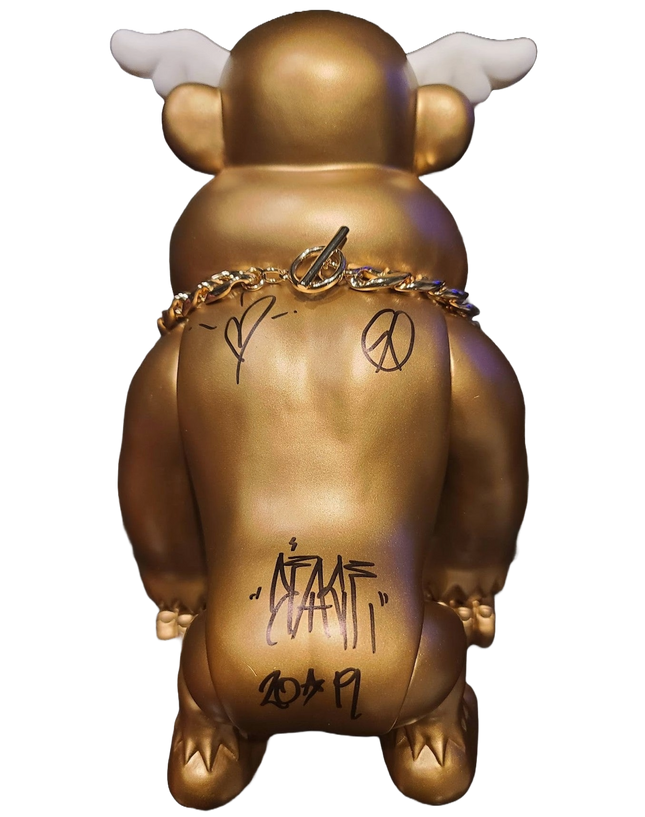
D*Face- Dean Stockton Xlarge Gorilla Dcon Cartoon OG 2019 Gold Signed Embellished Art by D*Face- Dean Stockton
Xlarge Gorilla Dcon Cartoon OG 2019- Gold Signed Original Embellished Drawing Limited Edition Vinyl Art with Gold Colored Metal Chain Toy Collectible Artwork by street graffiti artist D*Face x Medicom. 2019 Limited Edition Art Toy with Real Metal Chain Pendant XL Logo & Drawing Artwork Size 6x9.5. Small Hand Drawings of Heart and peace Sign, Tag, Throw Up Signature On The Back, Hand Embellished Permanent Marker. Includes Original Packaging. The XLarge Gorilla DCon Cartoon OG 2019 is a striking embodiment of the innovative artistry of D*Face, also known as Dean Stockton. This limited edition vinyl art piece is a significant representation of the fusion between street art's rebellious vibrancy and the sophisticated realm of art collecting. Characterized by its lustrous gold hue and adorned with a gold-colored metal chain, the piece exudes an urban luxury that is both captivating and thought-provoking. Created in collaboration with Medicom, a Japanese brand known for its art toys that cater to the meticulous collector's market, the artwork stands as a testament to DFace's ability to navigate multiple platforms of artistic expression. His works are often infused with satirical critiques of consumerism, pop culture, and the monotony of the corporate world. The Gorilla DCon piece, with its hand-embellished details such as the small drawings of a heart and peace sign and the artist's iconic tag and signature on the back, is a unique synthesis of art and personal touch, which is emblematic of DFace's style. Each stroke of the permanent marker on the back of the vinyl art is a signature of authenticity and individuality, making each piece in this limited edition a singular work of art. The street graffiti artist, having grown up in London, brings the influence of his environment into his work, combining it with elements of Los Angeles streetwear culture, particularly that of XLARGE, a brand known for its deep roots in music, skate, and street art. D*Face's integration of his street art heritage with the world of toy collectibles creates a nexus point for enthusiasts and collectors alike, making the XLarge Gorilla DCon Cartoon OG a coveted item for those who appreciate where the pulse of street art intersects with the exclusivity of limited edition collectibles.
$758.00
-

Cleon Peterson The Return Gold Silkscreen Print by Cleon Peterson
The Return Gold Silkscreen Print by Cleon Peterson on Hand Deckled 290gsm Coventry Rag Fine Art Paper Limited Edition Artwork. 2025 Signed & Numbered Cleon Peterson Limited Edition of TBD Artwork Size 20x20 Silkscreen Print of a Warrior Man on Horse with Bloody Sword. Released During January 2025, California Fires. The Return Gold Silkscreen Print: Cleon Peterson’s Vision of Conflict and Power The Return Gold Silkscreen Print by Cleon Peterson is a powerful representation of human conflict and resilience, expressed through the language of Street Pop Art and Graffiti Artwork. This limited-edition piece, released in January 2025, is crafted on hand-deckled 290gsm Coventry Rag fine art paper, offering a tactile richness that complements its striking visual impact. Measuring 20x20 inches, the artwork features a solitary warrior astride a horse, brandishing a bloody sword. Rendered entirely in gold ink against the paper’s stark white background, the piece exudes an aura of regality and violence, encapsulating the duality of triumph and destruction. Cleon Peterson and His Iconic Style Cleon Peterson is celebrated for his graphic, minimalist approach to storytelling, often exploring themes of violence, power, and survival. His work is deeply rooted in the tension between chaos and order, with stark compositions that evoke raw emotion. The Return Gold exemplifies this style, presenting a scene that is at once elegant and unsettling. Peterson’s use of simplified forms and bold silhouettes allows viewers to focus on the narrative elements of the piece, while the use of gold adds a layer of symbolism tied to wealth, power, and legacy. Released during the California fires of 2025, this artwork gains additional relevance as it parallels themes of destruction and endurance. Symbolism and Visual Impact in The Return Gold The central figure in The Return Gold is a commanding warrior on horseback, raising a sword still dripping with blood. This imagery speaks to themes of conquest, survival, and the cyclical nature of violence. The horse, a timeless symbol of power and freedom, adds to the piece’s dramatic intensity. The monochromatic gold palette amplifies the artwork’s impact, creating a luminous quality that contrasts with the grim subject matter. The hand-deckled edges of the paper emphasize the rawness of the work, grounding its polished aesthetic in the tactile authenticity of street-inspired art. Collectibility and Context of The Return Gold Printed on premium Coventry Rag fine art paper, The Return Gold is a testament to Cleon Peterson’s dedication to craftsmanship and narrative depth. Each print is signed and numbered, ensuring its exclusivity within an unspecified but highly anticipated edition size. The timing of its release during the California fires adds an additional layer of significance, drawing connections between the artwork’s themes and real-world events. As both a fine art print and a piece of Street Pop Art, The Return Gold blurs the lines between traditional and contemporary, offering collectors a meaningful and visually captivating addition to their collections. It stands as a reflection of Peterson’s mastery in distilling complex human experiences into bold, minimalist forms.
$400.00
-
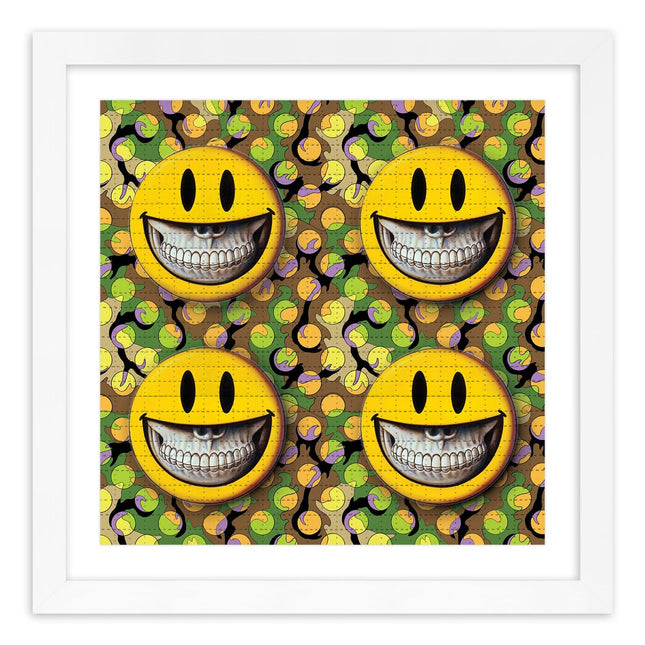
Ron English- POPaganda Grin Blotter Blotter Paper Archival Print by Ron English- POPaganda
Grin Blotter Paper Limited Edition Archival Pigment Print Art on Perforated Blotter Paper by Ron English- POPaganda pop culture LSD artwork. Ron English- POPaganda is widely considered a seminal figure in the advancement of street art away from traditional wild-style lettering into clever statement and masterful trompe l’oeil based art. He has created illegal murals and billboards that blend stunning visuals with biting political, consumerist, and surrealist statements, hijacking public space worldwide for the sake of art since the 1980s.
$371.00
-
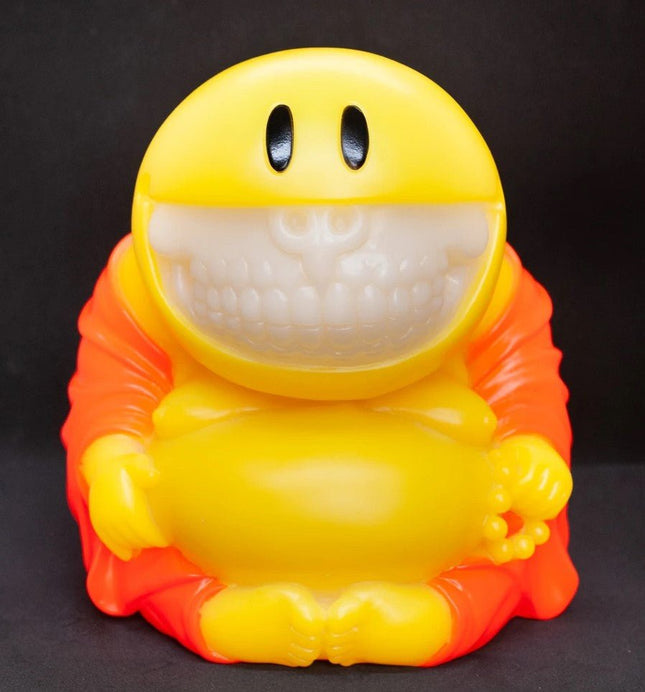
Ron English- POPaganda Mad Happy Monk Grin Orange Art Toy by Ron English- POPaganda
Mad Happy Monk Grin- Orange Limited Edition Blacklight Vinyl Art Toy Collectible Artwork by Street Graffiti Artist Ron English- POPaganda. 2019 Signed Limited Edition New In Box. Blacklight orange colorway of the Mad Happy Monk is 8 inches tall. Hand-signed by Ron
$225.00
-
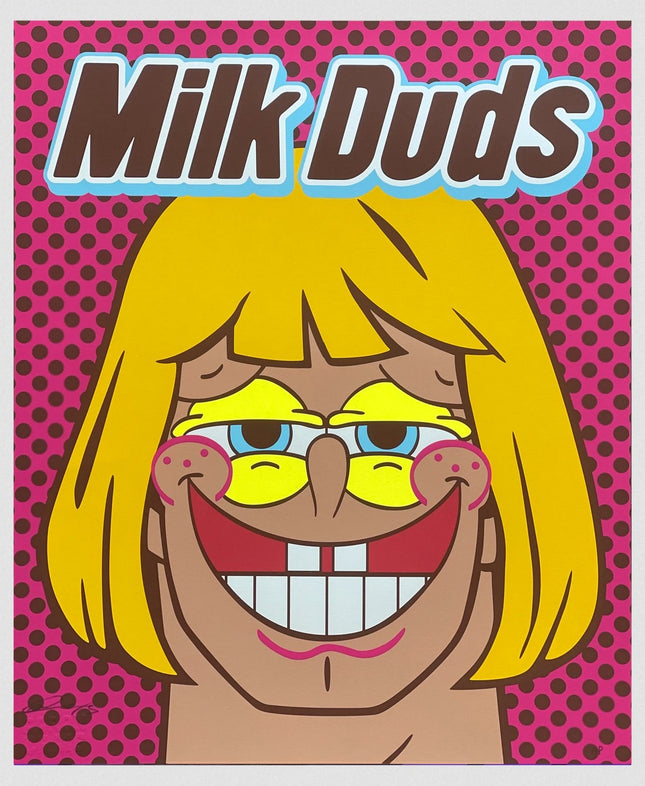
Aaron Craig- Pop Mash Milkduds Silkscreen Print by Aaron Craig- Pop Mash
Milkduds 8-Color Hand-Pulled Limited Edition Silkscreen Print on 270gsm Mohawk Superfine Eggshell Stock Paper by Aaron Craig- Pop Mash. 2021 Signed & Numbered Limited Edition of 20 Artwork Size 15.5x19 He-Man x Sponge Bob. 8 color hand-pulled screenprint 270gsm Mohawk Superfine Eggshell Stock Paper Hand signed, numbered and blind stamped by Aaron Craig Edition of 20
$352.00
-
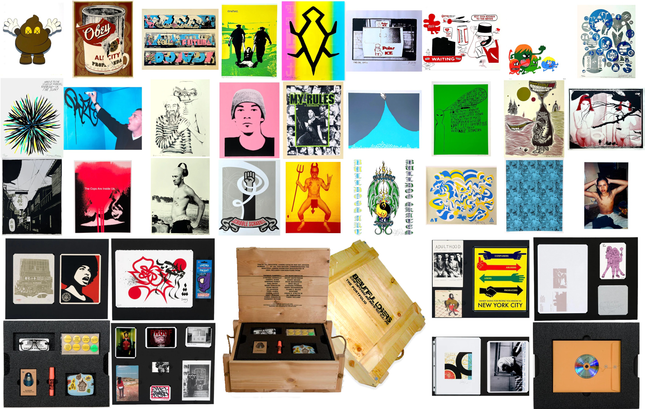
Kaws- Brian Donnelly The Beautiful Losers Portfolio Catalog Boxed 2006 Kaws Shepard Fairey
The Beautiful Losers Portfolio & Catalog Boxed Edition 2004-2010 Museum Crate Set Kaws- Brian Donnelly x Shepard Fairey- OBEY x Jonathan Levine Projects Featuring Legendary Graffiti Street Artwroks from Dozens of Artists During the 2004, 2005, 2006, 2007, 2008, 2009 & 2010 Show Run. The Beautiful Losers Portfolio and Catalog Boxed Edition, 2006 is a treasure trove for lovers of Street Pop Art and Graffiti Artwork, offering a comprehensive collection that captures the spirit of the iconic "Beautiful Losers" exhibition. This limited-edition set stands as a pristine testament to a defining moment in contemporary art and the raw creativity of the street art scene from 2004 to 2010. Each element of the set, carrying corresponding matching edition numbers, is in mint condition, ensuring its value as a collectible and a piece of art history. Original The Beautiful Losers Portfolio & Catalog Boxed Edition 2004-2010 Museum Crate Set x Jonathan Levine. Jonathan Levine Projects' The Beautiful Losers box sets 2004-2010 were released in a limited edition, with the Portfolio Box limited to under 30 editions and the Catalog Box limited to 100. Each set is housed in a custom printed and numbered wooden box, adding a layer of sophistication and care to the presentation of these artworks. The dimensions of these boxes, measuring 26 x 19 x 9 inches, were carefully chosen to accommodate the variety of works and their varying sizes, ensuring that the integrity of each piece is maintained. Iconoclast published these box sets on the occasion of the traveling exhibition "Beautiful Losers," which ran from 2004 to 2010. This exhibition, alongside "Transfer," which toured various locations from 2008 to 2010, showcased the burgeoning talent and diverse expressions within Street Pop Art and Graffiti Artwork. The Beautiful Losers exhibition and its accompanying publications, including the "Beautiful Losers: Contemporary Art And Street Culture" book published by Edition Iconoclast in 2005, have been pivotal in bringing the vibrancy and relevance of street and graffiti art to a broader audience. The Portfolio Box, a crucial component of these sets, is a treasure trove of 28 of the most influential street and graffiti artists. This collection includes prints from renowned artists like KAWS and Shepard Fairey, each bringing their unique vision and style to the forefront. Each piece within this box echoes the themes and artistic expressions in the broader Beautiful Losers exhibition, further underscoring this collection's significance in contemporary art. The Beautiful Losers Movie 2008 About the Art Show Beautiful Losers is a 2008 documentary that dives into the lives and art of a collective of artists who have played a pivotal role in the Street Pop Art and Graffiti Artwork movement since the 1990s. Directed by Aaron Rose and co-directed by Joshua Leonard, this film was a product of Sidetrack Films and BlackLake Productions, featuring artists like Harmony Korine and Steve "ESPO" Powers. The film explores the "do-it-yourself" ethos of these artists, whose work is steeped in the aesthetics of skateboarding, graffiti, and underground music genres such as punk rock and hip-hop. It casts a light on the journey of these artists from obscure street culture to becoming celebrated figures within the mainstream art world, detailing their personal feelings and convictions as they transitioned from creating for themselves to working on high-profile commercial projects. "Beautiful Losers" is more than a film; it is part of a more significant cultural phenomenon that includes a published art book of the same name, edited by Christian Strike and Aaron Rose, and a traveling museum exhibition that features the artists and their works. This exhibition serves both as a backdrop and a focus in the documentary, emphasizing the expansive influence of these artists and their continued relevance in contemporary art discourse. Artist Signed Limited Edition Silkscreens, Photos, Drawings & Art Objects 2004-20010 Beautiful Losers Contemporary Art and Street Culture Book 2004 Beautiful Losers: Contemporary Art and Street Culture, a seminal anthology published in 2004 by D.A.P./Iconoclast, this volume is an essential exploration of a vibrant subculture that transformed the aesthetics of the late 20th and early 21st centuries. This first edition is a collector's gem encased in a satisfactory condition hardback with a sleeve. The book's red cloth boards are embossed with gilt lettering on the front and spine, signaling the treasure within a profusion of illustrations and original works. This is no mere collection; it is a profound narrative detailing a cultural movement's organic, uncontrived emergence. It charts the journey of American artists, many freshly stepping into adulthood, who were propelled not by market demands but by pure passion and creativity. Without formal training or insider knowledge, they drew inspiration from the streets, influenced by the raw vitality of skateboarding, graffiti, street fashion, and independent music. Names like Shepard Fairey, Mark Gonzales, and Spike Jonze are among the many who channeled their lived experiences into their craft, learning through doing and revolutionizing their mediums. Beautiful Losers serves as both a tribute and a historical account, tracing the cultural threads from Jean-Michel Basquiat and Keith Haring to newer proponents such as Ryan McGinniss and KAWS. It features various artistic expressions across mediums, alongside reproductions of ephemera that encapsulate the era's spirit. The book is further enriched by essays from writers who have fervently supported these artists from their inception. It's not just an art book; it's an archive of a movement that left indelible marks on the art world and fashion, music, literature, film, and even athletics. The independent ethos these creators embodied may have evolved, yet their foundational spirit—a spirit of rebellion, innovation, and authenticity—remains unshaken. Beautiful Losers is a celebration of that enduring spirit, an invitation to witness the beauty in the raw, the unrefined, and the real. Kaws- Brian Donnelly: Warm Regards Letterpress Print 2005 Signed/Numbered 2005 Signed & Numbered Limited Edition of 200 Artwork Size 16x20. "Warm Regards," created in 2005 by KAWS, is a captivating piece of art rendered through letterpress on paper, measuring 20 x 16 inches. This artwork is part of a limited edition of 200, each meticulously signed and numbered by the artist. The piece was published explicitly by Iconoclast Editions to commemorate the "Beautiful Losers: Contemporary Art and Street Culture" exhibition, which ran from 2004 to 2009, marking a significant moment in the intersection of contemporary art and street culture. This artwork features a character that is a signature motif in KAWS' work, with its notable crossed-out eyes and exaggerated cartoon-like hands and feet. This print is from a limited edition series, with only 200 pieces available, each individually signed and numbered by the artist. It was published by Iconoclast Editions, likely as a celebration of the "Beautiful Losers: Contemporary Art and Street Culture" exhibition. The exhibition, which took place from 2004 to 2009, was a pivotal event showcasing the overlap of contemporary art with street culture. KAWS' work often bridges these two worlds, combining a commercial graphic design background with a sophisticated, gallery-worthy aesthetic. His characters are usually drawn from pop culture and are depicted in a playful and critical style, often reflecting consumerism and human emotion. Shepard Fairey- OBEY: Soup Can I Silkscreen Print 2005 Signed/Numbered 2005 Signed & Numbered Limited Edition of 200 Artwork Size 16x20. Shepard Fairey's "Soup Can 1" is an iconic piece from 2005, masterfully rendered as a silkscreen print on acid-free archival paper. The artwork is 20 by 16 inches and belongs to a limited edition series, with only 200 existing pieces, each bearing the artist's signature and edition number. Iconoclast Editions released this print to commemorate the pivotal "Beautiful Losers: Contemporary Art and Street Culture" exhibition from 2004 to 2009 and celebrate the synergistic relationship between underground art scenes and mainstream culture. The "Soup Can 1" print has graced a variety of prestigious exhibits, including the seminal "Beautiful Losers" traveling exhibition, "Transfer" at Santander Cultural in Porto Alegre, Brazil, and the comprehensive "Supply & Demand" show. It also appeared at the "Transfer" exhibition housed within the Brazilian Cultural Pavilion at Ibirapuera Park, São Paulo, Brazil, in 2010. Fairey's work during this period is documented in an array of publications, notably the "Beautiful Losers" collection from 2005-2009, the "Supply & Demand" book published by Rizzoli in 2009, and the 2010 edition of "Transfer." Each of these works provides insights into the artist's creative process and the cultural impact of his work. The provenance of "Soup Can 1" is securely rooted in the Beautiful Losers Archive, ensuring its place in the annals of contemporary street culture and affirming its status as a collectible piece of art history. Shepard Fairey- OBEY: Untitled Angela Davis Silkscreen Print 2005 Signed/Numbered This powerful silkscreen by the influential artist Shepard Fairey is a striking addition to his illustrious work. Sized at a prominent 8x10, this untitled piece is part of an exclusive edition of only 100 copies, each printed, numbered, and signed by Fairey himself, ensuring its rarity and collectibility. Fairey, renowned for his ability to infuse art with social commentary, presents a compelling portrait set against a bold red backdrop that demands attention. The high-contrast silhouette captures the strength and intensity of its subject, immortalizing a moment of passionate expression. The image is a visual echo of the past yet speaks to contemporary themes of empowerment and resistance. In the lower-left corner, Fairey's signature emblem—the star circled by the word "OBEY"—anchors the work, embedding the piece within his more extensive oeuvre known for challenging viewers to question authority and the landscape of visual culture. This artwork is a testament to Fairey's continued relevance in the art world and his steadfast commitment to making a statement through his art. Collectors and admirers of Fairey's work will recognize the artist's iconic style, which has become synonymous with the modern street art movement. Henry Chalfant: Lee, Futura, Dondi Silkscreen Print 2004 Signed/Numbered This compelling artwork, crafted by the esteemed Henry Chalfant, celebrates the street art movement, immortalizing the work of three graffiti legends: Lee, Futura, and Dondi. Titled "Lee Futura Dondi," this piece from 2004 is a silkscreen printed on acid-free archival paper, ensuring its preservation and quality for years. Measuring 16 x 20 inches, the work is substantial enough to make an impactful visual statement while still suitable for diverse display settings. The triptych format of the artwork presents a trio of vibrant, stylized subway cars, each adorned with the distinctive artwork of the graffiti above artists. The top panel bursts with energetic pinks and blues, showcasing Lee's iconic lettering style, while the middle features Futura's futuristic approach, with abstract forms and a cool-toned palette. The final panel is a tribute to Dondi's classic wildstyle, with bold lettering in shades of pink cutting through the background. Chalfant's work is not merely a static representation; it conveys the movement and rhythm of subway art as it once moved through the arteries of New York City. Each piece in this limited edition series is signed and numbered by Chalfant, marking its authenticity and connection to the artist. This series was published to coincide with the groundbreaking exhibit "Beautiful Losers: Contemporary Art and Street Culture," which showcased the intersections and influences of street art within contemporary art. This print is a collector's item, not only for its aesthetic and historical value but also for its representation of the evolution of street art from subways and city walls into the echelons of high art. Geoff McFetridge: Kemistry Original Drawing with DVD Animation 2004 This piece, created by Geoff McFetridge, is one of the 100 original drawings that compose an intricate animation sequence. Crafted with precision in pencil on Canson paper, each drawing measures 22.86 by 30.45 centimeters, capturing the minimalist aesthetic and fluid lines characteristic of McFetridge's work. This artwork showcases a playful scene of a figure skateboarding, rendered in a flowing, continuous line that conveys motion and a subtle sense of whimsy. A second character peeks curiously from the edge, adding a narrative element to the composition. Accompanying the original artwork, collectors receive a DVD containing the complete animation sequence, providing a rare glimpse into McFetridge's creative process and the animation's progression from still images to a dynamic visual experience. The artist signs Each drawing, providing a personal touch that assures authenticity. This offering is not merely an acquisition of a singular piece of art; it is an invitation to engage with McFetridge's visionary world where graphic design intersects with cinematic storytelling. This unique combination of traditional drawing and digital animation offers a multifaceted appreciation for the artist's innovative approach to contemporary art. Ed Templeton: Chris Johanson At The First Beautiful Losers Exhibition Photograph 2004 Signed Captured through the discerning lens of Ed Templeton, this photograph is a significant piece of contemporary art history, documenting the vibrant essence of the "Beautiful Losers" art movement. The image presents Chris Johanson, an artist synonymous with the DIY spirit of street art, at the first exhibition of "Beautiful Losers" in Cincinnati, Ohio, in 2004. This is an evocative silver gelatin print by Ed Templeton, depicting Chris Johanson at the inaugural "Beautiful Losers" exhibition. The photograph, sized at 8 x 10 inches, is part of a limited edition of 100, each individually signed by Templeton, marking its exclusivity and authenticity. Captured in 2004, this image is a timeless piece of art history, documenting a pivotal moment in the convergence of street culture and contemporary art. This photograph is a visual record and embodiment of the exhibition's ethos, celebrating the underground convergence of skateboarding, graffiti, and street art with contemporary art. The photo's composition is candid and unfiltered, showcasing Johanson with his face obscured by a white cloth, an enigmatic presence that stirs curiosity. This choice of presentation speaks to the themes of anonymity and mystery that often permeate street art culture. Johanson's obscured face, adorned with sunglasses atop the fabric and his untamed beard protruding beneath, creates a striking, visually arresting, and thought-provoking contrast. Signed by Ed Templeton, this photograph is a tactile connection to the moment it captures, bringing the viewer into the fold of a pivotal event in street and pop art history. Templeton's signature adds a layer of authenticity and marks this work as a genuine intersection of his photographic journey and Johanson's artistic narrative. "Chris Johanson At The First Beautiful Losers Exhibition" is a photograph transcending its medium, offering a glimpse into the community and camaraderie of the artists who defined a generation. This piece will hold a place of reverence for collectors and enthusiasts of the movement, encapsulating the raw, spontaneous energy that "Beautiful Losers" represented. Cynthia Connolly: Untitled Ice Machine Page, Arizona Photograph 1999 Signed/Dated This photograph by Cynthia Connolly, untitled yet poignantly capturing the essence of Page, Arizona, is a masterful silver gelatin print that embodies the spirit of the "Beautiful Losers" exhibition. The print, with dimensions of 4 x 6 inches, belongs to a limited edition series of 100, each painstakingly printed and signed by the artist, underscoring its collectible nature. The image focuses on an ice machine, a mundane yet iconic symbol of Americana in the everyday landscape. Dated 5/17/95, the photograph is not just a depiction of a place but a timestamp of an era. The handwritten annotation "Page, Arizona" adds a personal touch, evoking a sense of place and grounding the artwork in its geographical context. Connolly's photographic eye transforms the ordinary into the extraordinary, inviting viewers to find beauty and narrative in the commonplace. The stark contrast of the black and white image highlights the play of light and shadow, lending the ice machine a sculptural quality. This piece is a subtle exploration of form and texture, where even the utilitarian becomes a subject worthy of artistic contemplation. This print is essential for collectors who value the intersection of documentary photography and fine art. It is a testament to Connolly's commitment to capturing the overlooked nooks of American landscapes, making it an exceptional addition to any collection that celebrates the nuanced beauty of the mundane within the vast tapestry of American culture. Barry Mcgee: Untitled Ryze 2007 C-Print & Hand-Tagged Photograph Artwork Barry McGee's "Untitled Ryze" is a cornerstone of the contemporary art movement, symbolizing the vibrant intersection of street culture and fine art. This striking 2007 C-print, measuring 16 x 20 inches, is a highly coveted collectible, limited to an edition of 200. Each piece in the series bears the unique distinction of being hand-signed and numbered by McGee, an artist who rarely affixes his signature to his works. The artwork was released in conjunction with the seminal exhibition "Beautiful Losers: Contemporary Art and Street Culture," which spanned from 2004 to 2009 and a plethora of museums and galleries across the globe. The image captures the essence of Boston's legendary" street figure, Ryze, showcasing McGee's adeptness at translating the raw energy of graffiti into a refined gallery context. McGee's word extends beyond the photograph, as "Untitled Ryze" is pivotal in his larger installations and clustered assemblage pieces. The picture is a visual testament to the artist's legacy and a touchstone for the cultural zeitgeist The Beautiful Losers encapsulated. Acquired directly from Iconoclast Editions and the Beautiful Losers Archive, this piece represents a rare opportunity for fans and collectors alike to own a fragment of street art history seen through the lens of one of its most enigmatic and celebrated artist, Barry McGee. Barry McGee: Untitled Hello My Name Is Original Slap-Up Sticker 2005 Signed Tag Barry McGee, an influential figure in street pop art and graffiti artwork, has made a significant impact with his unique style and approach. His "Untitled Hello My Name Is Original Slap-Up Sticker 2005 Signed Tag" is a quintessential example of his work, blending the raw, energetic ethos of street art with the refined aesthetics of pop art. This piece, created in 2005, is a testament to McGee's ability to transform everyday objects and themes into compelling artistic expressions. McGee's journey in art began in the streets, where he honed his craft by creating graffiti under the tag "Twist." This formative period was crucial in shaping his distinctive style, characterized by a blend of graffiti's spontaneity and the bold, eye-catching essence of pop art. His transition from street walls to galleries did not diminish the raw authenticity of his work. Instead, it provided a new canvas for his expressions, allowing him to reach a wider audience while staying true to his roots in street culture. Terry Richardson: Untitled Devil Self Portrait Silkscreen Print 2004 Signed/Numbered Presenting a striking visual piece, this untitled self-portrait from 2004 is a silkscreen print on paper, measuring 20 x 16 inches, and part of a limited edition of 200. Each piece is individually signed and numbered by the artist, adding a personal touch to this exclusive artwork. The print features the artist in a vibrant yellow backdrop, posing with a playful yet rebellious demeanor. Adorning devil horns and wielding a trident, the subject playfully gestures a peace sign, juxtaposing traditionally nefarious symbols with a light-hearted attitude. The vivid monochromatic yellow tone of the print adds to the artwork's striking impact. This piece was released with the exhibition "Beautiful Losers: Contemporary Art and Street Culture" from 2004-2009. It explores the intersections of pop culture and street art, offering a subversive take on contemporary iconography. The artwork's provenance is notable, originating from Iconoclast Editions and the Beautiful Losers Archive, ensuring its authenticity and connection to a significant movement in modern art. This self-portrait is more than a mere image; it's a statement piece that captures the essence of a cultural zeitgeist, making it a compelling addition to any art collection. Evan Hecox: Kyoto Street Woodblock Print 2004 Signed/Numbered "Kyoto Street," a captivating silkscreen by Evan Hecox, presents a moment frozen in the timeless allure of Japan's old capital. Created in 2004, this piece of art is meticulously printed on acid-free archival paper, measuring 20 x 16 inches. It belongs to an exclusive edition limited to 200 prints, each hand-signed and numbered by Hecox himself, ensuring its place as a collectible item. This artwork was released as part of the influential "Beautiful Losers: Contemporary Art and Street Culture" exhibit from 2004 to 2009 and was showcased at various locations. The "Kyoto Street" print has been displayed in notable exhibitions, including "Transfer" at the Santander Cultural in Porto Alegre, Brazil, in 2008 and the Brazilian Cultural Pavilion in Ibirapuera Park, São Paulo, in 2010. In this piece, Hecox distills the essence of Kyoto's urban landscape into stark contrasts and clean lines, capturing the dynamic interplay of light and shadow. Lanterns adorned with kanji characters punctuate the scene, casting a warm glow over the alleyway. At the same time, the intricate web of power lines above adds a layer of complexity, suggesting the city's vibrant energy. The artwork's stark palette and bold graphic style evoke a sense of nostalgia, inviting viewers to contemplate the serene and bustling atmosphere of Kyoto streets. Preserved within the Beautiful Losers Archive, "Kyoto Street" is not just a print but a narrative piece chronicled alongside other contemporary masterpieces in the "Beautiful Losers" and "Transfer" catalogs. It is a testament to Hecox's ability to capture the urban environment's soul, making it a prized possession for collectors and admirers of contemporary art with a penchant for urban aesthetic and cultural depth. Ryan McGinness: Pathetic Lucky Charms of the Hipster Doofus Silkscreen Print 2004 Signed/Numbered Ryan McGinness, 'Pathetic Lucky Charms of the Hipster Doofus.' This exquisite piece from 2004 is a masterful representation of contemporary iconography, meticulously crafted through silkscreen on paper. Each print measures 20 by 16 inches and is part of an exclusive edition limited to 200 pieces, ensuring its uniqueness and collectible nature. Each print is hand-signed and numbered by the artist, a testament to its authenticity and McGinness's personal touch. The artwork was released in conjunction with the renowned exhibition 'Beautiful Losers: Contemporary Art and Street Culture,' which spotlighted the pulsating energy and vibrancy of street art within the context of contemporary art. The piece is a symphony of symbols, a visual lexicon reflecting the hipster subculture's ironic and often self-deprecating spirit. McGinness's use of iconic imagery, interwoven with playfulness and critique, encapsulates a moment where art, culture, and social commentary intersect with effortless grace. This work is not just a piece of art but a slice of cultural history, a mirror to the zeitgeist of the early 2000s urban landscape." Harmony Korine: Untitled Osama & E.T. Silkscreen Print 2005 Signed/Numbered This artwork is an enthralling silkscreen print by Harmony Korine titled "Untitled (Osama & E.T.)" from 2005. It is a limited edition work, with only 200 copies made, each hand-signed and numbered by Korine, elevating its status as a collector's item. This print, measuring 20 x 16 inches, showcases Korine's unique vision by juxtaposing two vastly different cultural references into one frame. The image represents Osama bin Laden in a warm embrace with the iconic extraterrestrial character, E.T., from Steven Spielberg's renowned film. Blending these images makes a bold statement and invites many interpretations of the convergence of disparate cultural symbols. The figure and E.T. are drawn with a delicate linearity that belies the weightiness of the subject matter, creating a striking visual paradox. This silkscreen print was released with the "Beautiful Losers" exhibition, which celebrated the intersection of skateboarding, graffiti, and street fashion with contemporary art. The provenance of the print is impeccable, coming from Iconoclast Editions and the Beautiful Losers Archive, adding to its historical and artistic significance. The pairing of such incongruous figures in this print challenges the viewer to reconcile the contrasting emotions and narratives each character represents. This piece is more than just a visual statement; it's a dialogue about pop culture, political figures, fictional characters, and their place within the artistic sphere. Collectors and enthusiasts of street pop art will appreciate this print's depth and provocative nature, making it a noteworthy addition to any compilation of contemporary artwork. Larry Clark: Untitled Shorty Photograph Artwork 1996/2007 Signed/Numbered This striking photograph titled "Untitled (Shorty)" is a profound work by the acclaimed artist Larry Clark. It was produced in 1996 and later published in 2007. It is presented on Anjelica watercolor paper with 20 x 13.75 inches dimensions. Each piece within this edition of 200 is individually signed and numbered by Clark himself, with an additional signature and date on the verso, ensuring its authenticity and rarity. Issued with the renowned "Beautiful Losers: Contemporary Art and Street Culture" exhibition from 2004 to 2009, this photograph emanates from the Iconoclast Editions and is an integral part of the Beautiful Losers Archive. Larry Clark, an influential figure in photography and film for over five decades, has left an indelible mark on the creative world through works like "Teenage Lust" and "Tulsa" and movies including "KIDS" and "Marfa Girl." The photograph captures the essence of Lyle Dean "Shorty" Easky, whose story intertwines with the artist's history and the broader narrative of American youth culture. Shorty, of Native American descent, tragically passed away in 2013. His life and untimely death remain a poignant tale, with roots stretching back to the same Tulsa neighborhood that inspired much of Clark's early work — the same locale that Francis Ford Coppola chose for "The Outsiders." Raymond Pettibon: Untitled Sun Silkscreen Print 2005 Signed/Numbered This striking work is an untitled piece from 2005 by the acclaimed artist Raymond Pettibon, known for his influential contributions to art and culture. The piece is a silkscreen on paper, a medium that allows for the vibrant and crisp presentation of Pettibon's dynamic design. It measures 20 x 16 inches, is scale accessible for various spaces, and commands enough to make a visual impact. Pettibon's creation is part of an exclusive edition of 200, with each piece signed and numbered by the artist, providing a direct connection to his creative process. The artwork features a burst of lines emanating from a central point, suggesting an explosive energy or a cosmic phenomenon. The use of black, coupled with highlights of blue and yellow, imbues the piece with a sense of depth and intensity, while the handwritten text at the top—"APPLY IT TO THE STUDY OF MIRRORS, RAINBOWS OR THE SUN!"—invites contemplation and lends a poetic dimension to the visual experience. This edition was published to commemorate the exhibit "Beautiful Losers: Contemporary Art and Street Culture," which celebrated the intersection of underground art and urban creativity. Pettibon's work is a testament to the ethos of this movement, encapsulating the raw spirit and the bold aesthetics that define the genre. It is a collector's item not only for its aesthetic appeal but also for its cultural significance within contemporary art. Evan Hecox: Chinatown NYC Woodblock Print 2004 Signed/Numbered Evan Hecox's 'Chinatown NYC,' a 2004 woodblock print on delicate Japanese rice paper, articulates urban vibrancy meticulously. Each print within this limited series measures 10 x 8 inches and is part of a numbered edition restricted to 100, underscoring its exclusivity. Each piece is printed and personally signed by Hecox, lending a touch of the artist's direct involvement in the collector's experience. This work captures the essence of New York's bustling Chinatown with a keen eye for detail and a distinctive stylistic approach. Hecox's use of lines in the woodblock medium translates the dynamic nature of the city into a static image that pulses with life. The artist masterfully conveys the architectural complexity of the urban landscape, complemented by the human element that breathes life into the city. The nuanced layering of the print, with its intricate linework and subtle tonal variations, echoes the layered experiences of urban life. Renowned for his ability to distill the spirit of a locale into his artwork, Hecox presents 'Chinatown NYC' as more than just a visual representation; it's a narrative woven in ink and paper, a story told through the rhythm of a cityscape. This piece reflects Hecox's artistic prowess and is a homage to the cultural tapestry that defines Chinatown and the ever-evolving story of New York City itself. Rostarr- Romon K Yang: Untitled Japan HPM Spray Paint Silkscreen 2005 Signed/Numbered Experience the fusion of tradition and rebellion with Rostarr's 'Untitled Japan HPM,' a provocative piece by Romon K Yang from 2005. This striking work, rendered on paper with dimensions of 27.94 x 33.02 cm, is a harmonious blend of spray paint and silkscreen techniques, culminating in a limited edition of just 100 copies, each individually signed and numbered by the artist. The artwork is a testament to Rostarr's distinctive visual language, where calligraphic strokes meet the spontaneity of street art. Bold red forms anchor the composition; their fluid contours and solid circles contrast sharply with the raw, improvised splatters of black spray paint. This interplay of color and form creates a dynamic tension, a visual symphony that captures the spirit of contemporary art. Each piece of 'Untitled Japan HPM' is a hand-painted, hand-printed celebration of unique expression, standing as a bold signature of Rostarr's iconic style. The artwork's limited availability makes it a coveted piece for collectors and enthusiasts eager to hold a part of art history that bridges the gap between the old and the new, the planned and the spontaneous. 'Untitled Japan HPM' is not just an artwork; it's a piece of cultural dialogue that resonates with the beats of modern urban life. Rostarr- Romon K Yang: Butterfly In The Hurricane 2004 Silkscreen Print Signed/Numbered Embark on a visual journey with 'Butterfly In The Hurricane,' a captivating silkscreen on paper by the acclaimed artist Rostarr, created in the transformative year of 2004. This piece exemplifies the dynamic interplay between form and fluidity, measuring an intimate 20 x 16 inches, and is part of an exclusive edition of 200, each bearing the unique signature and number assigned by the artist himself. Crafted during artistic exploration and boundary-pushing, 'Butterfly In The Hurricane' was released in conjunction with the groundbreaking exhibition 'Beautiful Losers: Contemporary Art and Street Culture,' which celebrated the confluence of underground art movements and the mainstream. The artwork features a storm of abstract shapes and curves, predominantly in shades of blue and yellow, evoking the chaotic grace of a butterfly caught in a storm. The bold colors swirl and dance across the paper, inviting viewers to contemplate the relationship between harmony and chaos. This piece is not merely a work of art; it's a statement, a slice of cultural history, and a testament to the artist's mastery of blending street culture's raw energy with the sophistication of contemporary art. 'Butterfly In The Hurricane' is a must-have for connoisseurs and collectors alike, promising to be a conversation starter and a cherished part of any collection. Craig R Stecyk III: Untitled 2004 Unique HPM Silkscreen Photograph Signed/Numbered A distinctive piece by Craig R. Stecyk III, this untitled artwork from 2004 is a brilliant example of the fusion between contemporary art and street culture. Crafted with meticulous attention to detail, the work features a hand-painted custom airbrush backdrop, a double-sided silkscreen is masterfully applied, along with pencil accents on robust, extra-thick white acid-free archival paper measuring 20 x 16 inches. Limited to an edition of 200, each piece is individually numbered and bears the artist's signature, underscoring its exclusivity. This artwork was released with the "Beautiful Losers: Contemporary Art and Street Culture" exhibit, which spanned from 2004 to 2009 and is held in high esteem within the Beautiful Losers Archive. The provenance of this piece traces back to Iconoclast Editions, a testament to its authenticity and cultural significance. Stecyk, a seminal figure in the Beautiful Losers project, created an installation that captivated audiences and garnered unprecedented acclaim. His work is a tribute to the vibrant Californian subcultures, drawing inspiration from custom car culture, surfing, and skateboarding, all depicted through his extensive photographic documentation. As a founding member of the Dogtown and Z-Boys, Stecyk's works are more than mere art; they are storied representations of a decadent cultural movement, rendered on paper with a palette that resonates with the energy and spirit of the streets. This piece is an artistic expression and a cultural artifact that captures the essence of Californian subcultures, immortalized through Stecyk's visionary lens. Craig R Stecyk III: Untitled Proof Gelatin Silver Silkscreen Print Signed/Numbered Craig R. Stecyk III's untitled piece is a statement of originality and artistic defiance. It is a part of an exclusive set of 100 artworks, each a gelatin silver and silkscreen print on paper, measuring 10.16 by 15.24 centimeters. The artwork boldly features the word "PROOF" in prominent red letters, asserting the piece's authenticity as an original generation photographic print. The text beneath serves as both a declaration and a restriction, emphasizing the print's purpose as a contractual document and expressly prohibiting reproduction, resale, and public display. The artist's signature underscores this boundary of exclusivity, scrawled energetically across the print, which authenticates each piece and marks it as a unique entity within the limited edition. The signature becomes an integral part of the artwork, blending with the textual message and the stark background, ensuring that each print is a testament to Stecyk's unique artistic philosophy and legacy within the art community. Tobin Yelland: Untitled Andy Roy Silkscreen Print 2004 Signed/Numbered Tobin Yelland's "Untitled (Andy Roy)" is a striking silkscreen that captures the essence of individuality and defiance, hallmarks of street culture. Produced in 2004, this piece features the image of Andy Roy, a figure synonymous with the skateboarding world, known for his raw style and unapologetic persona. Printed on high-quality paper, each piece within this limited edition spans 20 x 16 inches and is part of a series capped at 200 prints. Each is meticulously signed and numbered by Yelland, guaranteeing its authenticity and placing it within a lineage of sought-after collectibles. The artwork was created for the influential "Beautiful Losers: Contemporary Art and Street Culture" exhibition from 2004 to 2009. This exhibition was pivotal for celebrating and acknowledging street culture within the contemporary art scene, bringing the aesthetics of skateboarding, graffiti, and beyond into the gallery space. Originating from Iconoclast Editions and the Beautiful Losers Archive, "Untitled (Andy Roy)" is more than a portrait; it's a narrative of subculture, an emblem of the rugged spirit of street art, and a snapshot of a movement that has left an indelible mark on the canvas of contemporary art. Collectors and admirers of the genre will find in this silkscreen a piece that continues to resonate with the authenticity and vibrancy of street culture. Tobin Yelland: Skate Smash Window PhotMills' Signed/Numbered Tobin Yelland's "Skate Smash Window Photo" is a raw and dynamic black and white photograph that seizes a candid moment of youthful rebellion. Captured in 2004, this image epitomizes the spirit of the street and skate culture of the time. The photo showcases the spontaneity and impulsiveness inherent in the skateboarding subculture, embodied by the act of a skateboard crashing through a car window. The photograph was featured in the seminal "Beautiful Losers: Contemporary Art and Street Culture" exhibition, which took place from 2004 to 2009. This exhibition celebrated the fusion of street sensibilities with the art world, bringing the authenticity of subcultural experiences into a fine art context. Originating from the Beautiful Losers Archive, with provenance through Iconoclast Editions, this piece is not just a photograph but a narrative, a slice of life from a culture that often goes undocumented. Yelland's ability to capture such a raw, unfiltered moment creates a visceral connection with the viewer, offering a window into the unrestrained aspects of youth culture. The "Skate Smash Window Photo" is a testament to the era it represents, serving as a historical document of the defiance and disruptive energy that skateboarding means. It is a valuable piece for collectors and enthusiasts of photography and street culture, offering an unapologetic look at the moments defining a movement. Mike Mills: The Cops Are Inside Us Silkscreen Print 2004 Signed/Numbered Mike Mills' evocative piece "The Cops Are Inside Us." stands as a profound statement in contemporary art, utilizing the raw medium of hand-printed silkscreen combined with pencil on soft white acid-free archival paper. This 2004 work measures 20 x 16 inches and is part of an exclusive edition limited to 200 signed and numbered prints. Each print from this series is a testament to Mills' keen eye for the interplay of text and image, crafting a narrative that speaks to the internal struggle and societal introspection. The bold red hue dominating the print, fading into a stark, gritty representation at the bottom, creates a striking visual contrast, suggesting a duality within the human condition. This artwork was released with the pivotal "Beautiful Losers" exhibition showcased from 2004 to 2009. The exhibit highlighted the cultural significance of street art and its impact on contemporary art practices. "The Cops Are Inside Us" reflects the sentiment of its era and continues to resonate with current social commentaries, making it a timeless piece for collectors and enthusiasts of meaningful art. Coming from the revered Beautiful Losers collection, this piece by Mike Mills is not just a work of art; it is a piece of cultural commentary, preserved through silkscreen and offering a window into the complex dialogue between society and self. Cheryl Dunn: Drafted 2004 Signed/Numbered Silkscreen Print & Signed Photograph Cheryl Dunn's "Drafted." is a provocative silkscreen artwork that starkly captures a moment of human interaction, set against a vibrant yellow backdrop. This 2004 creation measures 20 x 16 inches and is part of a limited edition of 200, each individually signed and numbered by the artist, underscoring its exclusivity. The artwork presents a high-contrast scene featuring silhouetted figures, one seated on the ground and the others seemingly in motion. Dunn's silhouettes create a universal narrative, allowing viewers to impart their stories and meanings onto the piece. The title "drafted." suggests themes of compulsion and resistance, resonating with viewers on a deeply personal level. Released during the influential "Beautiful Losers: Contemporary Art and Street Culture" exhibition, which spanned from 2004 to 2009, this piece contributes to the dialogue between street culture and fine art. The exhibition was a pivotal showcase for artists influenced by subcultural forms such as skateboarding, graffiti, and punk. Emerging from the prestigious Beautiful Losers Archive and produced by Iconoclast Editions, "drafted." is more than a piece of art; it's a cultural artifact that embodies the spirit of a movement. It is a powerful expression of Dunn's perspective and a visual commentary on the forces shaping our society. Collectors of contemporary art and street culture lovers will find a compelling blend of aesthetic boldness and social relevance in this work. Cheryl Dunn: C-4 San Francisco Tenderloin Hallway Giclee Print 2004 Signed/Numbered Presenting a captivating giclée print by Cheryl Dunn, this work transports the viewer to the vibrant heart of San Francisco's Tenderloin district. The piece, titled "C-4 San Francisco Tenderloin Hallway," is a testament to Dunn's keen eye for the raw and the real, capturing an evocative moment in a hallway that whispers tales of the city's urban fabric. The print measures display-friendly 15 by 10 inches, meticulously numbered and personally signed by Cheryl Dunn, signifying its authenticity and connection to the artist's original vision. This limited edition print is one of only 100 copies, making it a unique and collectible piece for art lovers and admirers of urban exploration. The subject stands in the narrow corridor, embodying a sense of stillness amidst the potential for city chaos. The individual is clad in a striking red and green jacket, adorned with whimsical bear ears that lend an air of innocence to the otherwise gritty scene. This person holds a spray paint can, suggesting a story of street art and expression. At the same time, the jacket pockets are intriguingly stuffed with additional cans, perhaps hinting at the artist's commentary on youth, rebellion, or creativity in urban spaces. Cheryl Dunn's print not only offers a visual narrative but also evokes a discussion on the cultural heartbeat of city life, the layers of stories packed into its walls, and the vibrant characters that walk its paths. This piece is more than a photograph; it's a slice of San Francisco's soul, beautifully preserved in high-quality giclée. Cynthia Connolly: Untitled Ice Machine Silkscreen Print 2004 Signed/Numbered Cynthia Connolly's "Untitled" from her "Ice Machines" series is a captivating silkscreen on paper, measuring an impressive 16 x 20 inches. This piece is part of a limited edition run of 200, each bearing the artist's signature and a unique number, marking its authenticity and limited availability. Crafted with an eye for the Americana aesthetic, this artwork is a poetic documentation of the once-ubiquitous ice machines dotted the American landscape, now a vanishing emblem of a bygone era. Connolly's work is celebrated for its ability to capture these fleeting slices of American life, preserving the nostalgia and cultural significance that these everyday objects hold. The "Untitled" print was published to commemorate the "Beautiful Losers: Contemporary Art and Street Culture" exhibition, which took place from 2004 to 2009. This exhibition was a pivotal moment that brought the rawness of street culture into the refined spaces of art galleries, highlighting the work of artists who draw inspiration from street aesthetics, skateboarding, and the undercurrents of subculture. Connolly's photographs, renowned for their poignant simplicity and depth, are held in the permanent collections of esteemed museums. This print, part of the "Ice Machines" body of work, reflects her dedication to chronicling elements of American life that are slowly fading from view. For collectors and admirers of contemporary art with a touch of nostalgia, Connolly's "Untitled" is a must-have. It's not just a silkscreen print; it's a piece of cultural heritage, a thoughtful reflection on the transient nature of the every day, and a beautiful work of art from a distinguished photographer and artist. Geoff McFetridge: The Hidden Radiance Silkscreen Print 2004 Signed/Numbered "The Hidden Radiance" by Geoff McFetridge is a testament to the artist's mastery of visual rhythm and narrative within the confines of silkscreen printing. Created in 2004, this silkscreen on paper measures 20 x 16 inches, a size that allows the intricate patterns and striking blue palette to envelop the viewer's field of vision—each element within the tessellated design pulses with an energy emblematic of McFetridge's graphic artistry. Upon closer inspection, one can discern the meticulous composition of abstract and figurative forms. This patterned artwork is a sophisticated visual puzzle where geometric and organic shapes converge to create a sense of depth and movement. The repetition of the elements serves an aesthetic purpose and weaves a deeper narrative, alluding to the interconnectedness of individuals within a community or the repetitive yet unique nature of urban landscapes. Signed by the artist, this piece holds the personal touch of McFetridge, ensuring its authenticity and connecting the collector directly to the creative process. "The Hidden Radiance" was featured in the renowned "The Beautiful Losers Portfolio" at Agnes B Gallery in Los Angeles as part of a collection celebrating the synergy between contemporary art and street culture. It is also highlighted in the pivotal book "Beautiful Losers: Contemporary Art and Street Culture," published by Edition Iconoclast, which documents this artwork's cultural phenomenon. This silkscreen print is a decorative piece integral to the dialogue between street pop art and mainstream art scenes. It is a collector's piece that captures the essence of McFetridge's influence on the visual language of contemporary art. This language speaks to the discerning art enthusiast and the vibrant street culture aficionado. Ed Templeton: Untitled Shocked Woman Silkscreen Print 2004 Signed/Numbered Presenting a compelling piece by Ed Templeton, "Untitled Shocked Woman" is a work that encapsulates the raw and expressive potential of silkscreen printing. Crafted in 2004, this piece measures 16 x 20 inches and is part of a limited edition of 200, each signed and numbered by Templeton, ensuring its exclusivity and collectible status. This silkscreen print showcases Templeton's unique ability to capture the human condition in its most vulnerable and candid moments. The artwork features the image of a woman, her expression of surprise or shock, a narrative moment frozen in time by Templeton's adept hand. The use of stark, contrasting colors and the overlay of abstract elements give this piece a dynamic quality that is both disturbing and intriguing. The imagery is imbued with immediacy and intimacy, characteristic of Templeton's approach to art. It challenges viewers to confront the unexpected and often unsettling emotions that his subjects display. The raw brushstrokes and the deliberate obscuring of details invite an exploration into the themes of privacy, emotion, and the voyeuristic nature of art. "Untitled Shocked Woman" was published during the seminal exhibition "Beautiful Losers: Contemporary Art and Street Culture," which celebrated the intersection of underground art scenes and mainstream recognition. Templeton's work is a testament to the power of street pop art to convey profound human experiences, making this piece a valuable acquisition for collectors and enthusiasts of contemporary art. James Jarvis x Amos Toys: In-Crowd The Thin Blue Line Wiggins Signed Figure Fine Art Toy 2004 He is introducing the "In-Crowd: The Thin Blue Line Wiggins" - a limited-edition of 100 signed series 3.5x6 collector's item that merges the imaginative world of James Jarvis with the tangible delight of fine art toys. Created in collaboration with Amos Toys, this figure represents a unique synthesis of art, collectibility, and narrative, culminating in a 6-inch (approximately 10cm) vinyl figure named Wiggins, part of a highly exclusive series limited to just 1660 overall pieces worldwide. Wiggins, the diminutive law officer, stands proudly in his uniform, crafted with meticulous attention to detail. From the top of his classic police hat to the soles of his steadfast boots, every element of his attire has been thoughtfully designed to reflect his character's essence. He holds a club, an accessory that hints at his readiness to jump into action and restore order. Yet, his face, with a mustache poised above a stern expression, suggests a depth of personality beyond his official duties. Each figure arrives encased in a beautifully designed box, proudly displaying the signature of James Jarvis, a mark of authenticity and a direct connection to the artist's hand. The packaging is as much a work of art as the figure itself, with the silhouette window showcasing Wiggins in a presentation that blurs the line between toy and art sculpture. Wiggins is not just a character but a storyteller in his own right, embodying the complexities of his profession with a twist of Jarvis's characteristic humor and insight. According to his backstory, when not patrolling the streets, he is penning confessional poetry, providing a glimpse into his sensitive soul—a contrast to his authoritative figure. This piece is a must-have for fans of street pop art and those who appreciate the intersection of art and playfulness. It is a tribute to the offbeat charm and creative vision that James Jarvis is renowned for, making "In-Crowd: The Thin Blue Line Wiggins" a standout addition to any collection of fine art toys or contemporary art pieces. ESPO- Steve Powers: Untitled Next Door HPM Silkscreen Print 2006 Signed/Numbered Steve Powers' "Untitled (Next Door...)" is an exemplary piece of contemporary art, blending the rawness of street art with the sophistication of a gallery piece. This silkscreen on paper, measuring 16 x 20 inches, is part of a limited edition of 200, each individually signed and numbered by the artist, ensuring its status as a collector's item. A standout feature of this artwork is that each print includes unique hand-drawn elements by Powers, making every piece a one-of-a-kind treasure. The artwork is infused with Powers' characteristic wit and visual language, featuring bold graphics and textual interplay that convey a complex narrative. Published in conjunction with the celebrated "Beautiful Losers: Contemporary Art and Street Culture" exhibition, which spanned from 2004 to 2009, this print captures the essence of a movement that blurred the boundaries between underground and mainstream art. The varied elements, from the "Misfit" puzzle piece to the sad figure with a top hat, all speak to themes of identity, societal pressures, and the existential search for meaning. Originating from Iconoclast Editions and the Beautiful Losers Archive, Powers' "Untitled (Next door...)" is not merely a piece of printed art; it's a dialogue with the viewer, a satirical commentary on the human condition, and a reflection of Steve Powers' (aka ESPO) distinctive voice in the world of art. This piece will complement any art collection and serve as a conversation starter due to its vibrant imagery and the artist's unique storytelling prowess. ESPO- Steve Powers: Handy Signs for People You Know in New York City Custom HPM Print 2006 Steve Powers, also known as ESPO, brings the dynamic essence of urban communication to life with his "Handy Signs for People You Know in New York City" from 2006. This collection of die-cut stickers is more than mere decoration; it's a form of expression, embodying the pulse of New York City's streets. Each sticker is a burst of color and symbolism, measuring 12-1/8 x 10-1/4 inches, designed to capture the attention and provoke thought. This piece cleverly categorizes the various archetypes one might encounter in the bustling metropolis: "CONFUSERS" with a pointing hand in blue, "ABUSERS" with a thumbs down in red, "USERS" with a pointing finger in green, and "PRODUCERS" with a handshake in black—the background's vibrant yellow acts as a visual megaphone, amplifying each sign's message. Powers' artwork is a commentary on the social dynamics of city life, each sign a shorthand for the complex interactions that define the urban experience. Released as a custom, high-pressure matte (HPM) die-cut sticker sheet, these stickers are designed to adhere to any surface, turning everyday objects into mediums for social dialogue. "Handy Signs for People You Know in New York City" is an interactive art piece and a cultural artifact that reflects the artist's keen observation of the characters that make up the fabric of city life. For collectors and admirers of Steve Powers' work, this sticker sheet is a unique blend of graphic design, street art, and wry commentary—all hallmarks of Powers' distinct style. Jo Jackson: Untitled Silkscreen Print 2004 Signed/Numbered & "States" Artist Book Jo Jackson's "Untitled" from 2004 is a serene silkscreen print that captures the minimalist essence of natural forms through color and shape. Measuring 16 x 20 inches, this work is part of a limited edition series, with each piece signed and numbered by the artist, underscoring its exclusivity and collectible value. States is a limited edition flip book zine of 100. The print features a stark, icy peak set against an excellent blue background, evoking a sense of calm and contemplation. The mountain's apex is met with a singular, detailed snowflake, suggesting the purity and uniqueness of nature's creations. Below, a field of white dots dances across the base, reminiscent of a quiet snowfall or a starry night sky. Released in alignment with the "Beautiful Losers: Contemporary Art and Street Culture" exhibition from 2004 to 2009, Jackson's artwork reflects the introspective and often meditative qualities that contemporary art can elicit. The exhibition was a landmark event showcasing artists who drew inspiration from street culture, graffiti, skateboarding, and other subcultural art forms. Emerging from the Beautiful Losers Archive, this piece represents a moment in contemporary art where simplicity and symbolism converge. For collectors and enthusiasts alike, Jackson's "Untitled" is not just a print but a piece of tranquil beauty, offering a moment of reflection amidst the chaos of everyday life. It is a testament to the artist's ability to distill complex emotions into a single, poignant image. Thomas Campbell: People Of Pangea Silkscreen Print 2005 Signed/Numbered Thomas Campbell's "People Of Pangea Unite" is a compelling silkscreen on paper that encapsulates a whimsical and thought-provoking perspective on unity and the natural world. This 2005 piece is part of a limited series, individually signed and numbered by the artist, making each print a collectible artifact. The artwork portrays a surreal landscape where human figures merge with the trunk of a tree, creating a visual metaphor for interconnectedness. Above, a speech bubble unfurls with the text, "WHAT EXACTLY ARE CONSERVATIVES CONSERVING," a provocative prompt encouraging viewers to ponder political and environmental stewardship. The piece is punctuated with vibrant splashes of color amidst an otherwise earth-toned palette, drawing the eye across the playful composition. Published for the "Beautiful Losers: Contemporary Art and Street Culture" exhibition, which ran from 2004 to 2009, Campbell's print embodies the exhibition's celebration of subcultural art forms and their influence on contemporary art. The exhibition was a significant cultural event, bringing the ethos of skateboarding, graffiti, and street art into the gallery space. "People Of Pangea Unite" is a testament to Campbell's unique ability to blend the fantastical with the critical, offering a statement that is both aesthetically pleasing and intellectually stimulating. For collectors, this print is not just a piece of art; it's a conversation piece that captures a distinctive moment in contemporary art history, characterized by its boldness and ability to challenge the status quo. Thomas Campbell: T Moe Still Smoking Paul Frank Limited Edition Hand Made Custom Wallet 2005 Thomas Campbell's "Still Smoking" is a bespoke, handcrafted wallet, a functional piece of art that fuses utility with the vibrancy of the street culture. Created in 2005, this limited edition item celebrates personal style and artistic flair. Adorned with a myriad of whimsical illustrations that are signature to Campbell's aesthetic, the wallet boasts a light blue background with vivid, contrasting images. From the playful depiction of clouds to the stylized structures and whimsical figures, each element is rendered with a sense of joy and a bold, graphic sensibility. The wallet was released as part of commemorating the "Beautiful Losers: Contemporary Art and Street Culture" exhibition, which took place from 2004 to 2009. This global event was a landmark for showcasing the intersection of skateboarding, graffiti, and street art within the contemporary art scene. Campbell's "Still Smoking" wallet is not just an accessory but a collectible piece that captures the essence of an era where art was not confined to galleries but was carried in the pocket, a part of the everyday. It is a tribute to the spirit of "Beautiful Losers" and a must-have for collectors who appreciate the blend of art and everyday life. Andy Jenkins: Untitled Hang Unique HPM Print 2005 Signed/Dated A compelling piece from Andy Jenkins, this artwork is part of a unique collection of 100 inkjet prints, each approximately 11 by 9 inches. This untitled work is a symphony of visual elements, combining typography, graphic design, and hand-drawn illustrations to create a layered narrative. The piece boldly features the word "HANG" in oversized, staggered letters that dominate the visual field, set against a backdrop that intriguingly blends elements of a calendar and handwritten script, suggesting the passage of time and the fleeting nature of moments. A sketched rocket positioned alongside the typography adds a dynamic sense of motion and exploration, further enriching the story told by the print. Each print in this limited edition is individually signed and dated by Jenkins, ensuring its authenticity and connecting the collector directly to the artist's creative journey. This artwork is not just a visual statement but a testament to Jenkins' multidisciplinary approach, where text and image are interwoven to engage and challenge the viewer. Andy Jenkins: Untitled Circle HPM Unique Print 2005 Signed/Dated Andy Jenkins' "Circle Untitled HPM Print" from 2005 is a remarkable example of contemporary printmaking that marries the simplicity of geometric forms with the complexity of individual expression. This piece, one of a hundred unique inkjet prints, each measuring approximately 11 by 9 inches, showcases Jenkins' mastery of form, color, and composition. The artwork features two bold, black circles dominating the visual field; they form a study of perfect symmetry and balance. Surrounding these central figures appear to be handwritten notes and doodles, some clear, some obscured, hinting at the artist's process or perhaps thoughts left intentionally cryptic. The print is set against a pristine white background, which not only accentuates the vividness of the black circles and the red accents within one of them but also gives prominence to the subtle text and line work that invite the viewer to lean in closer. Each print in this series is signed and dated by Jenkins, indicating a personal touch and authenticity that collectors and admirers of art often seek. The limited edition nature of these prints makes each one unique in terms of its place in the series and the slight variations that occur in inkjet printing. Jenkins' "Circle Untitled HPM Print" is not just a visual experience but a tactile one as well, with the artist's choice of paper and printing technique contributing to the overall presence of the work. It is a testament to Jenkins' ability to convey depth and narrative within the minimalist framework, engaging the observer in a silent, reflective, and universal dialogue. With its clean lines and intriguing details, this piece is a compelling addition to any collection that values the intersection of modern design and personal expression within fine art printmaking. Andy "Mel Bend" Jenkins: Scribble Scrabble Silkscreen Print 2005 Signed/Numbered Andy Jenkins' "Scribble Scrabble" is an intriguing silkscreen and graphite work on paper, capturing the viewer's imagination through its bold graphic quality and playful engagement with typography. Measuring 20 x 16 inches, this piece is part of a finite edition of 200, each numbered and personally signed by Jenkins, affirming its uniqueness and collectible status. The composition features a raised fist entwined with flowing, ribbon-like lines against a backdrop of soft grays, punctuated by the eponymous "Scribble Scrabble" banner in striking black and red. Jenkins' graphic sensibility, honed through years as a pivotal creative in skateboarding culture, is on full display, merging elements of street art with delicate art sensibilities. Released with the seminal "Beautiful Losers: Contemporary Art and Street Culture" exhibition from 2004 to 2009, "Scribble Scrabble" represents the creative evolution of skateboarding's aesthetic into gallery spaces. Jenkins, a versatile artist known for his work as a comic artist, illustrator, and creative director, co-founded Dirt magazine with Spike Jonze and Mark Lewman in the early 1990s, further cementing his influence in the subculture. "Scribble Scrabble" by Andy Jenkins is more than a print; it reflects a creative force shaping skateboarding culture's visual language. It holds a place of honor within the Beautiful Losers Archive, representing a time when the lines between subculture and high culture were blurred and beautifully intertwined. Terry Richardson: Smilen Broadway Eye Glasses Art Object 2004 This intriguing art object by Terry Richardson, titled "Smilen Broadway Eye Glasses," is a testament to the fusion of functional design and artistic expression. Presented as an art object from 2004, this pair of black eyeglasses represents Richardson's distinctive visual style, known for its boldness and directness. The glasses measure approximately 3 x 8 x 3 inches, embodying a sense of style within their compact form. The eyeglasses rest against a backdrop that reads "BROADWAY Collection SMILEN EYEWEAR," suggesting a theme of commercialism intertwined with personal identity. The clear acrylic lenses are set in a classic black frame, a color choice with timeless appeal. These glasses are not just accessories; they are statement pieces that reflect the wearer's personality and the artist's unique perspective on everyday objects. Crafted with meticulous attention to detail, the glasses carry the specifications "STYLE STEVEN COLOR BLACK SIZE 56-16 TEMPLE 145," denoting their bespoke nature. The art object blurs the lines between practical objects and collector's items, challenging the boundaries of what is typically perceived as art. Richardson's work here invites viewers to contemplate the intersection of visual culture, fashion, and personal expression, making it a compelling addition to any collection that values the innovative integration of art into daily life. Ari Marcopoulos: Justin Silkscreen Print 2004 Signed/Numbered Capturing a moment in contemporary portraiture, "Justin" by Ari Marcopoulos is a 2004 silkscreen creation on acid-free archival paper, measuring 20 x 16 inches. This work is part of a coveted limited edition series, with only 200 pieces, each meticulously signed and numbered by Marcopoulos, ensuring its exclusivity and collectible status. Set against a bold pink background, the portrait of 'Justin' is a compelling study of character and form. The stark contrast between the vivid backdrop and the monochromatic subject allows the figure to emerge with depth and introspection. The subject's neutral expression is rendered with a minimalist aesthetic, capturing a serene yet penetrating gaze that seems to look beyond the paper. This piece was published to mark the "Beautiful Losers" exhibit, a celebration of art that blurs the lines between street culture and high art. It reflects the movement's ethos, encapsulating a raw, unadulterated snapshot of youth and subculture. "Justin" is not just a portrait; it is a statement, a piece that speaks to the collector with an appreciation for the convergence of the art form with the zeitgeist of its time. It is a timeless addition to any collection, offering aesthetic beauty and cultural significance. Ari Marcopoulos: "I Might Be Wrong" Artist Art Book 2005 This image is a striking visual piece from Ari Marcopoulos' art book, "I Might Be Wrong," released as a limited fanzine in 2005 numbered limited edition of 100. This compelling work showcases Marcopoulos' skill in capturing street culture's raw and authentic essence. The photograph, printed in offset for precise, sharp detail, measures 20.32 x 12.7 cm, a size that invites close inspection and personal engagement with the viewer. In this monochrome portrayal, a figure stands before a weathered brick wall, their identity concealed behind what appears to be a boombox with eyes, evoking a sense of urban anonymity and artistic subterfuge. The boombox is a poignant symbol of the music and street scenes of the past decades, suggesting a narrative that intertwines personal expression with cultural artifacts. The backdrop is plastered with flyers, including one prominently featuring an announcement for the Alleged Gallery, providing context and anchoring the image in a specific cultural milieu. This edition numbered and limited to 100 copies, is a collector's item, offering an intimate glimpse into the artist's perspective on urban life and art. Marcopoulos is known for his documentary style that often explores the fringes of mainstream culture, and this image is a testament to his ability to find beauty and meaning in the everyday. Collectors and admirers of contemporary photography and street art will recognize the value of this art book as a touchstone for the dynamic and ever-evolving narrative of street culture. Todd James: Alive with Pleasure Silkscreen Print 2005 Signed/Numbered Introducing "Alive With Pleasure" by Todd James, a remarkable 2005 silkscreen creation on paper that vibrates with the artist's iconic energy and stylistic flair. This piece, measuring 7 x 5 inches, is part of an exclusive numbered edition of 100, making it a rare collectible for contemporary art enthusiasts. In this work, James continues to explore the themes of joy and exuberance that permeate much of his oeuvre. The composition features two figures rendered in a monochromatic pink hue that is striking and playful. The foreground is dominated by a character holding a smoke, her expression of unadulterated happiness, eyes closed, and a wide, toothy smile conveying a sense of contentment and delight. Behind her, a second figure, partially obscured, echoes this sentiment with a hand over her mouth smoking, suggesting laughter or a shared secret. James's line work in "Alive With Pleasure" is fluid and confident, with a cartoonish exaggeration immediately recognizable as his signature style. The characters are adorned with details such as the rainbow motif on the central figure's shirt, which adds a layer of visual interest and could be interpreted as a nod to themes of diversity and inclusion. This silkscreen print is not just a piece of art; it's a snapshot of happiness, a representation of life's simple pleasures, and a celebration of the moments that make us feel truly alive. It's a testament to Todd James's ability to capture the spirit of street pop art and package it in a format that resonates with the viewer on a visceral level. For collectors and admirers of Todd James's work, "Alive With Pleasure" is more than an artwork—it's an infusion of joy and an accurate representation of the artist's enduring appeal. Todd James: BullieJames'screen Print 2005 Signed/Numbered Presenting "Bullies" by the acclaimed artist Todd James, also known in the art circles as REAS, this 2005 silkscreen on paper is a vibrant testament to his renowned style deeply rooted in street culture and animated aesthetics. Measuring 20 x 16 inches, this piece is part of a limited edition of 200, each individually signed and numbered by the artist, ensuring its uniqueness and collectability. The artwork showcases four cartoon-like characters, each rendered with exaggerated expressions and gestures that convey a sense of movement and interaction. With its green complexion and fist raised, the dominant figure symbolizes the 'bully' archetype, a recurring theme in REAS's work, which often explores power dynamics and societal roles through a playful yet critical lens. Released in conjunction with the "Beautiful Losers: Contemporary Art and Street Culture" exhibition, "Bullies" encapsulates the energy and ethos of the street culture movement. The use of bold, primary colors and fluid lines is characteristic of Todd James's approach, where he blends elements of graffiti art with a refined art sensibility. This piece is a visual delight and a significant part of the dialogue between street art and mainstream contemporary art. It resonates with the rebellious spirit of the underground scenes from which Todd James emerged while also holding a mirror to society's broader narratives of confrontation and resilience. "Bullies" is a compelling example of Todd James's impact on the evolution of graffiti and street pop art, making it a coveted piece for collectors and enthusiasts. It embodies the fusion of street savvy and aesthetic finesse, a hallmark of James's artistic journey and a colorful addition to any collection. Wes Humpston: Bulldog Skates Silkscreen Print 2004 Signed/Numbered Featuring a striking blend of bold imagery and vibrant colors, the 'Bulldog Skates artwork by Wes Humpston is a profound piece that captures the essence of skateboarding culture. Created in 2004, this work is crafted with silkscreen and graphite on paper and stands at 20 x 16 inches. It belongs to a special edition limited to 200 pieces, each meticulously numbered and personally signed by the artist, establishing a direct connection between Humpston and the collector. This artwork was unveiled during the critically acclaimed exhibit "Beautiful Losers: Contemporary Art and Street Culture," which celebrated the rich visual language of street culture and its influence on contemporary art. 'Bulldog Skates' is emblematic of Humpston's distinctive style, incorporating elements of street pop art and graffiti artwork. The central image—a fiery-eyed bulldog encapsulated within vibrant green flames—is not just a logo but an icon representing skateboarders' rebellious spirit and fiery passion. The vertical text that borders the central figure, reminiscent of graffiti tags, bears the name 'Bulldog Skates', reinforcing the brand's identity and roots in street art's gritty, raw energy. Humpston's artwork is a testament to the authenticity and creative freedom that defines the street skating scene, resonating with enthusiasts and art collectors alike. 'Bulldog Skates' is more than a piece of art; it is a cultural artifact that embodies the spirit of an era and a community that thrives on the edge of societal norms. Glen E Friedman: My Rules Silkscreen Print 2004 Signed/Numbered This dynamic silkscreen creation, 'My Rules,' by the acclaimed artist Glen E. Friedman, was produced in 2004. This piece, a bold representation of street culture's impact on visual arts, measures 20 x 16 inches and is part of a limited edition series, with only 200 prints available worldwide. Each piece is individually signed and numbered by Friedman, adding a personal authentication to the collector's item. Crafted with the precision and vibrancy characteristic of silkscreen printing, 'My Rules' serves as a visual manifesto of the punk and skateboarding ethos. The artwork was unveiled as part of the iconic 'Beautiful Losers: Contemporary Art and Street Culture' exhibition, which celebrated the crossover of street art into the gallery space. 'My Rules' is an emblem of the artist's storied career in documenting the rebellious spirit of youth subcultures. The print is a montage of energetic portraits and live-action shots, centering around a commanding figure vocalizing the title's sentiment. The electric lime-green typography slices through the monochrome backdrop, asserting the defiant tone of the work. This piece is not just an artwork; it is a historical archive that captures the pulse of a movement. It embodies the voice of a generation that challenged norms and lived by their own rules. Owning a piece from this edition is not just an investment in art; it's an acknowledgment of a transformative period in contemporary art, where the streets conversed with the studio, and Glen E. Friedman was there to capture it all. Chris Johanson: Untitled Why Are They So Frantic Silkscreen 2004 Signed/Numbered Untitled Why Are They So Frantic? by Chris Johanson is a compelling silkscreen that speaks volumes through its combination of text and imagery. Created in 2004, this piece is meticulously printed on acid-free archival paper, measuring 20 x 16 inches. It is part of a limited edition series, with only 200, each hand-signed and numbered by Johanson himself. This artwork was conceived for the groundbreaking "Beautiful Losers: Contemporary Art and Street Culture" exhibit that celebrated the influential movements in skate, graffiti, and street art from 2004 to 2009. The piece features an alien figure rendered in a minimalist outline, which serves as a conduit for a message that challenges the viewer to reflect on issues of hysteria and vulnerability within society. The bold, bright green backdrop accentuates the urgency and reflective nature of the text. Johanson's work traveled across various locations as a part of the "Beautiful Losers" exhibition. It was later featured in the "Transfer" shows in Brazil, at Santander Cultural in Porto Alegre and the Brazilian Cultural Pavilion in Ibirapuera Park, Sao Paulo. The influence and reach of the piece are further documented in the "Beautiful Losers" and "Transfer" bibliographies. Originating from the Beautiful Losers Archive, this artwork is a piece of visual culture and a historical snapshot, encapsulating the ethos of a movement that blurs the lines between the gallery and the street. It offers a unique opportunity for collectors and enthusiasts to engage with a pivotal time in contemporary art through Johanson's introspective lens. Chris Johanson: Love Not War Button Badge Set 2004 Numbered Chris Johanson's "Love Not War" is a thought-provoking collection of button badges measuring ten by 17.78 centimeters. This set, presented in a limited edition of 100 copies, reflects Johanson's engagement with contemporary socio-political themes encapsulated within each badge's brief, powerful messages. The badges, set against a vibrant backdrop of yellow with one standout in green, serve as wearable art that invites reflection and discourse. They echo the artist's commitment to peace, support for grassroots entrepreneurship, and critique of consumer culture and war. Each badge is a conversation starter, from advocating for human rights vigilance in global commerce to promoting inner tranquility and love. This numbered collection is a piece of art and a historical commentary, capturing the essence of advocacy and personal expression in miniature manifestos. Johanson's artistry turns wearing a badge into a statement of unique ethos and a call to social consciousness. Mark Gonzales & Harmony Korine: "Adulthood" Artist Art Zine 1995 "Adulthood" is a poignant collaborative art zine from 1995 by Mark Gonzales and Harmony Korine, artists known for their influential work within the skateboarding and film communities, respectively. This fanzine is a physical manifesto of the era's subculture, rendered through the photocopied medium that gives it a raw, authentic aesthetic. Measuring approximately 20.32 x 12.7 cm, the zine is a handheld testament to the DIY ethos that permeated the underground art scenes of the time. The cover features a grainy, high-contrast image of four young men, evoking the style of early 20th-century portraiture yet brimming with the defiant attitude of the 90s. Beneath the image, the names "Mark Gonzales" and "Harmony Korine" boldly declare this collaborative effort, uniting two distinct creative forces in a shared vision. The title "ADULTHOOD" looms above in stark, typewritten letters, juxtaposed with the date "First ish. March 1995," anchoring the piece in a specific moment of cultural production. Limited to 100 copies, this edition is as much a collectible as it is a slice of cultural history, capturing the ethos of a generation poised on the cusp of adulthood yet profoundly entrenched in the subversive youth culture of the time. Each zine serves as a snapshot of the period, a tangible artifact that embodies the spirit of collaboration and creativity that Gonzales and Korine are celebrated for. This work is a must-have for collectors and enthusiasts of 90s skate culture, indie film, and the raw energy of street-inspired art. Mark Gonzales: Limited Edition Krooked Air Freshener Art Object 2004 Embodying the skate culture aesthetic, Mark Gonzales presents the Limited Edition Krooked Air Freshener, a vibrant art object marring functionality with street art flair. Released in 2004 as part of the Beautiful Losers Portfolio, these air fresheners transcend their practical use, standing as collectible pieces reflective of Gonzales's artistic vision. Each air freshener features the distinctive Krooked skateboarding brand's playful and irreverent character, rendered in bold, graphic outlines. Available in two designs, the first flaunts a rich purple hue, embodying the Krooked eyes motif. In contrast, the second design showcases the brand's signature character in a stark white against a striking blue background. These art objects were curated for the seminal "Beautiful Losers: Contemporary Art and Street Culture" exhibition, which celebrated the influential DIY spirit in art from 2004 to 2009. The collection taps into the heartbeat of street culture, infusing everyday items with a sense of artistry and rebellion against the mainstream. Originating from Iconoclast Editions and the esteemed Beautiful Losers Archive, the Krooked Air Fresheners holds a special place in the chronicles of contemporary art. They serve as a testament to GGonzales' impact on the skateboarding and art communities and a symbol of the era's diffusion of underground art with everyday life. These limited edition pieces are coveted by collectors and enthusiasts, representing a moment when street culture boldly claimed its space in the world of high art. Phil Frost: Custom Superwide Poster Refillable Marker 2004 Phil Frost presents a unique fusion of utility and artistry with his Superwide Marker and Poster Marker, crafted in 2004. These custom plastic refillable markers are more than mere tools; they are individual art pieces, standing approximately 2 x 5 inches, and are part of a limiwoman'stwomen'siwomen's00 each. The markers are adorned with FFrost's distinctive tribal-esque motifs in black against a vivid orange backdrop. This design is instantly recognizable to those familiar with FFrost'swork, known for its intricate patterns and a keen sense of the priMill's yet contemporary visual language. Sourced from Iconoclast Editions and part of the Beautiful Losers Archiv", these markers embody the ethos" of the "Beautiful Losers: Contemporary Art and Street Culture" exhibition. This project celebrated the DIY culture and street art that influenced a generation of artists. For MMills'srs, these markers are a tangible slice of the exhibition, encapsulating the essence of street culture's impact on contemporary art. They are a testament to the vision where the everyday object becomes a canvas, blending form and function with the fluidity of street art. These markers are functional items and collectible works that carry the artist's artist's signature style into the hands of creatives and art enthusiasts alike. Mike Mills: The Architecture of Reassurance 1999 Mini Book Mike MMills's" The Architecture of Reassurance" is a captivating softcover artist book that serves as a visual extension of his short film. Released in 1999, this first edition book measures 7 x 4.25 inches and is a rare collectible sourced directly from the Beautiful Losers Archive. Within its pages, the book offers a rich collection of photographs and film stills that capture the essence of a young woman's women's women's journey through the suburban landscapes around Los Angeles. These images are woven together to create a narrative that explores themes of urban isolation, the search for identity, and the comforting yet sometimes sterile uniformity of residential design. Mill's work is renowned for its ability to distill profound socio-cultural observations into minimalist visuals. "the Architecture of Reassurance" is no exception, reflecting thoughtfully on our environments and how they shape our experiences and perceptions. This intimate publication is a book and a portable gallery of MMills's cinematic and photographic talent. For admirers of MMills' work and those interested in the interplay between film, photography, and urban theory, this artist is an invaluable addition to their collection, offering a tactile piece of the late 20th-century zeitgeist. Clare Rojas: Peggy Honeywell Faint Humms Limited Edition CD 2004 This art object is a limited edition CD titled Peggy Honeywell "Faint Humms" by Clare E. Rojas, an artist whose work spans a variety of mediums, often exploring themes of identity and folklore. Released in conjunction with the influential exhibit "Beautiful Losers: Contemporary Art and Street Culture," this CD is not only a vessel of Rojas' auditory art but also a collectible item that represents the intersection of music and visual art within the street culture milieu. The CD is presented in a striking orange case, which underscores Rojas' bold use of color in her visual artworks. The case is enveloped in a foam liner, ensuring the protection of the disc and echoing the care typically given to preserve art objects. The disc, with its reflective surface creating a spectrum of colors, is reminiscent of Rojas' characteristic style, which often employs vibrant, contrasting hues. This piece is a tangible connection to the ethos of the "Beautiful Losers" exhibition, which celebrated the diverse art forms emerging from street culture and its influence on contemporary art. As a limited edition release, this CD is a snapshot of a particular moment in art history, embodying the creative spirit of an era where the lines between different artistic disciplines were blurred to create new forms of expression. Collectors and enthusiasts of Clare E. Rojas' work and those who appreciate the legacy of street culture in art will find this CD a meaningful addition to their collection. Ryan McGinness: Custom Sticker Pack 2005 Signed/Numbered This art piece is a Custom Multiverse Sticker Pack by Ryan McGinness, an artist renowned for graphic representations and organic forms. The pack, released in 2005, is part of a special edition, limited to 100 copies, each meticulously signed and numbered by McGinness, indicating its position as #of 100. The dimensions of the case are 12.7 x 12.7 cm, a compact size that encapsulates the essence of McGinness' design philosophy. Presented in a sleek silver case that shimmers with a metallic sheen, the pack embodies a sense of exclusivity and modernity. The artist's signature on the left side of the envelope certifies the work's originality. At the same time, the iconic crown emblem of the Ryan McGinness Studios logo on the right is a stamp of quality and authenticity. Inside, the case contains an array of stickers, each a fragment of McGinness' vibrant multiverse. These are not mere embellishments; they are adhesive artworks, allowing the bearer to carry a piece of the McGinness aesthetic into the world. The stickers serve as a portable gallery, a democratization of art at the heart of McGinness' ethos. This Multiverse Sticker Pack is a collectible that blurs the boundaries between high art and the accessible art form of stickers. For admirers of Ryan McGinness' work, this pack is a unique opportunity to own a piece of art history that is interactive, playful, and deeply rooted in the visual language of contemporary culture.
$26,253.00
-
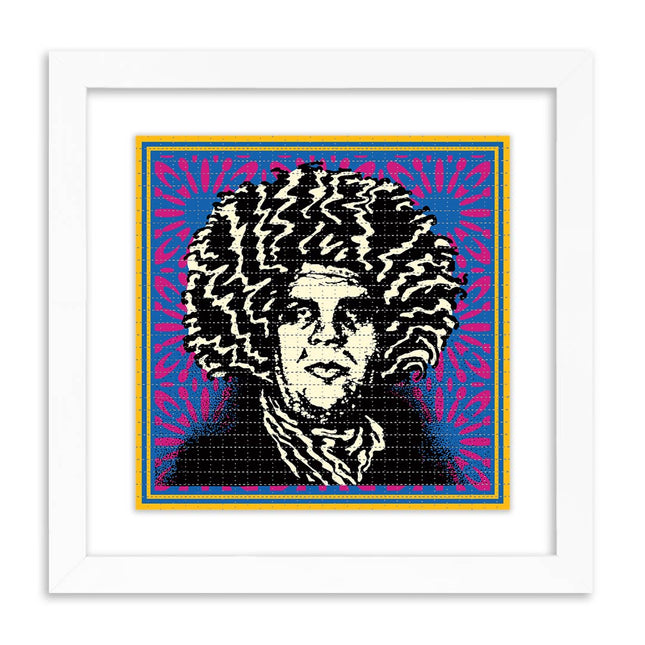
Shepard Fairey- OBEY Psychedelic Andre- ‘92 Obey Giant Blotter Paper Print by Shepard Fairey- OBEY
Psychedelic Andre- ‘92 Obey Giant Blotter Paper Limited Edition Archival Pigment Print Art on Perforated Blotter Paper by Shepard Fairey X John Van Hamersveld pop culture LSD artwork. "I first made this image in 1967, and then the poster came out in 1968. One day I sat down and started this drawing out of my style. I had been an art director at Capitol Records, and I hadn't been drawing very much. It was a whole new state I was in. But it was an opportunity to test my drawing and put it into a poster and have it published. It all came out great. It was a fantastic show. There were ads everywhere and people loved the poster. It just started to become a piece of history right away, much like The Endless Summer poster." - John Van Hamersveld "I became a fan of Hendrix after I exited my punk rock orthodoxy phase. I ended up gravitating towards John's image because it had that nod to psychedelia, without going so overboard in the baroque detail, that it remained iconic. This Hendrix image itself — along with a few other influences, like Barbara Kruger and Russian Constructivism — was a huge influence in how I was going to make work that had the ability to cut through the clutter of what's on the street and still have a recognizable style. When I was just making variations of the Andre on the different backgrounds, I was looking at a lot of psychedelic work, but John's piece really inspired me to make something that was a deviation from just playing it safe with the original Andre image. So John's Pinnacle Hendrix was sort of a gateway to the evolution of my entire Andre The Giant project. I can't really understate the importance of this image for me." - Shepard Fairey
$384.00
-
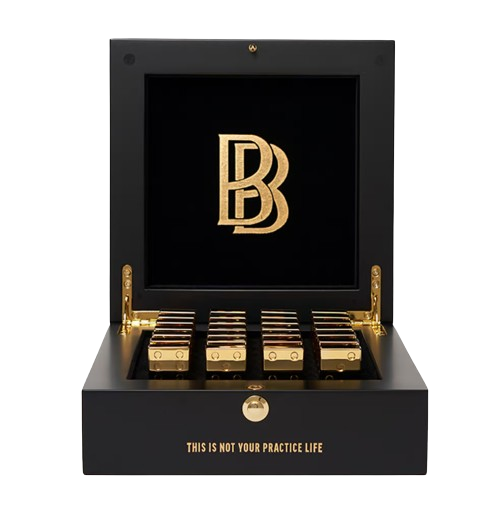
Ben Baller Gold Domino Set Object Art by Ben Baller
Gold Domino Game Set Object Art by Ben Baller, a Limited Edition Designer Collectible Pop Artist Artwork. 2022 Limited Edition of 2000 Rare Golden Domino Game Set & Box Object Art New In Box. Reimagining Play: Ben Baller's Gold Domino Game Set as Object Art The Gold Domino Game Set Object Art by Ben Baller epitomizes the fusion of luxury and play, a limited edition set that redefines traditional gaming through the lens of pop artist artwork. A mere 2,000 pieces of this rare collection were crafted in 2022, each one a testament to the innovative spirit of contemporary art movements. The set is encased in a box that is as much a part of the artwork as the dominoes themselves, with the resounding message "THIS IS NOT YOUR PRACTICE LIFE" inscribed, echoing the ethos of Street Pop Art and Graffiti Artwork. The transformation of a classic game into a designer collectible reflects the Street Pop Art tendency to elevate the mundane to the magnificent. By incorporating gold—a material that has historically symbolized wealth and power—into a playful context, Ben Baller invites a dialogue on the juxtaposition of value and entertainment. The dominoes are not merely game pieces but also individual works of art, each carrying the potential to form countless combinations and outcomes, much like the freeform nature of graffiti art. This domino set transcends its function as a game, entering the realm of interactive art. It is designed to engage, serve as a focal point for social interaction, and be a tactile experience that delights in its aesthetic and use. The gold set, presented new in the box, carries an air of exclusivity and the anticipation of an artifact yet to be explored. Golden Play: The Domino Set as a Symbol in Street Art Culture In the Street Pop Art and Graffiti Artwork culture, symbols and icons are often repurposed to challenge perceptions and critique societal norms. Ben Baller's Gold Domino Game Set stands as a symbol of the intersection between high art and popular culture, where the act of play is encapsulated in a luxurious form. The game set becomes a canvas, reflecting the artist's vision and the playful undercurrents of street art. The domino set also mirrors the communal aspects of street art—just as murals and tags become part of the neighborhood fabric, so does this game set invite community and camaraderie. The act of playing dominoes is a universal language, bridging cultures and generations, much like street art's ability to communicate across diverse audiences. The "BB" logo, synonymous with Ben Baller's brand, serves as a signature on this collective experience, marking each game as part of a larger narrative. Furthermore, the set aligns with the pop art movement's exploration of consumerism and the commodification of leisure. It questions the boundaries between art and object, between a gallery piece and a household item. In this way, the Gold Domino Game Set is not just an object of play but a statement of the cultural significance of games and their role in our lives. Artistic Investment: Collecting the Gold Domino Game Set For collectors, the allure of Ben Baller's Gold Domino Game Set lies in its dual identity as a functional game set and a piece of limited edition art. As an investment, it represents the convergence of artistic expression and the cultural cache of collectible design. This set is emblematic of a trend in art where the lines between practical items and art objects are not just blurred—they are deliberately intertwined. The limited edition nature of the set—only 2,000 in existence—elevates its status within the art and collectibles market. It becomes a sought-after piece for its beauty, craftsmanship, rarity, and potential to appreciate. As a collectible, it holds a story, a piece of the artist's vision, and a moment where artistry and play are celebrated in golden harmony. The Gold Domino Game Set by Ben Baller is a cultural artifact at the crossroads of Street Pop Art, Graffiti Artwork, and luxury design. It is a celebration of the playful spirit that underpins much of pop art, a luxurious interpretation of a timeless game, and a nod to the collective joy of shared experiences. This set is not merely a collection of golden dominoes; it is a compendium of art, play, and the enduring message that life, with all its games and gambles, is not a rehearsal but a stage for splendor and spectacle.
$563.00
-
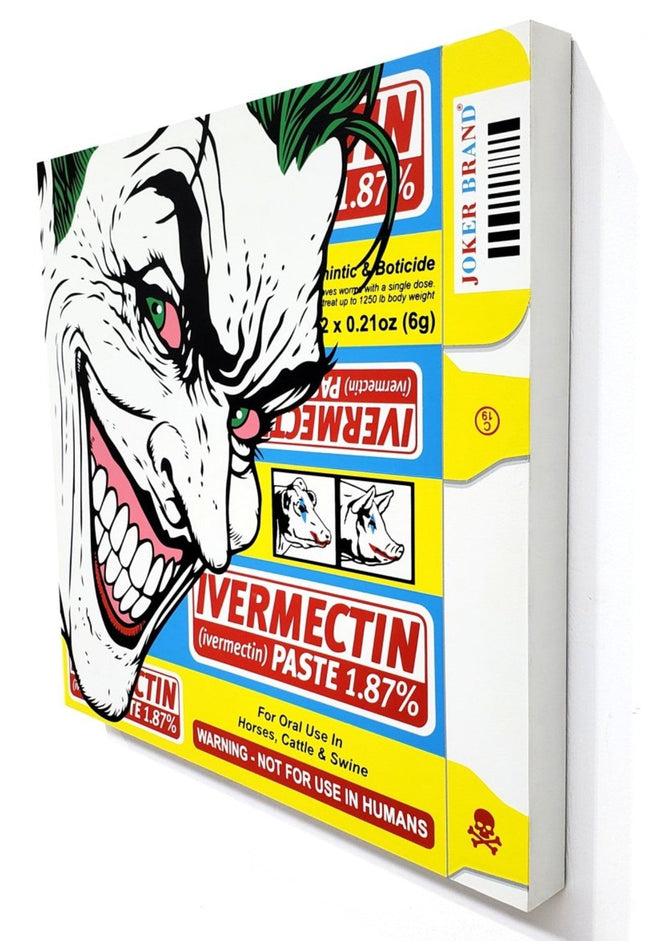
Ben Frost Joker Brand- Green Pink Original Spray Paint Acrylic Painting by Ben Frost
Joker Brand- Green Pink Original One of a Kind Mixed Media Acrylic & Spray Paint Painting Artwork on Cradled Wood by Popular Street Graffiti Artist Ben Frost. 2022 ‘Joker Brand’ - Acrylic and spray paint on board - Green/Pink variant 60cm x 60cm (23.5 x 23.5 inches) Signed, titled and dated on the reverse
$5,463.00
-
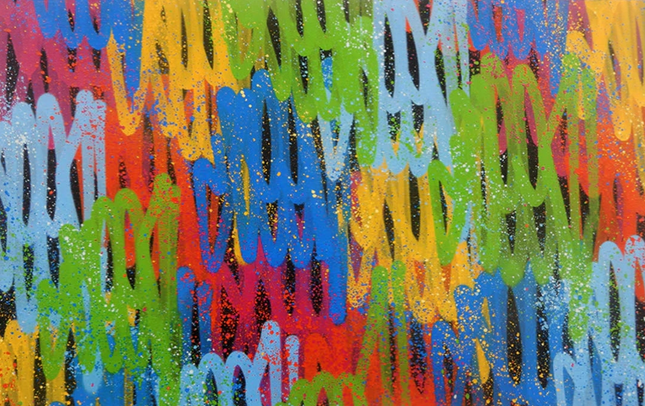
Seen UA Multi Tags Series 8465 Original Graffiti Painting by Seen UA
Multi Tags Series 8465 Original Graffiti Painting by Seen UA One of a Kind Spray Paint & Acrylic Painting Artwork on Stretched Canvas. 2023 Signed on Back Original Multi Tags Series Acrylic & Spray Paint Painting Size 52x34 Original canvas from SEEN, Multi Tags Series, 2023. The actual painting size is 34" x 52" (86,3 x 132 cm) with an added 2" border (5 cm) around all four sides for stretching on wood. Stretched size is 30" x 48" (61 x 122 cm) // UN- stretched size is 34" x 52" (86,3 x 132 cm). Multi Tags Series 8465 is an original graffiti painting by legendary street artist Seen UA, whose real name is Richard "Richie" Mirando. A pivotal figure in the graffiti and street art movement, Seen UA rose to prominence in the 1970s and 1980s. Originally from the Bronx, New York, Seen UA began his artistic career by tagging subway trains and quickly gained recognition for his unique style and skillful lettering. In the Multi Tags Series, Seen UA showcases a variety of graffiti styles, techniques, and forms, creating a visually captivating composition. As the title suggests, the painting features multiple tags, a signature element of graffiti art. These tags often represent the artist's street name or the name of their crew. The work showcases Seen UA's distinct talent for incorporating bold, vibrant colors and intricate designs, blending them harmoniously in a dynamic and energetic composition. Through this piece, the artist continues to push the boundaries of graffiti art, demonstrating its legitimacy as a powerful form of artistic expression. UA's artwork has been exhibited in galleries and museums worldwide, and his influence on the graffiti and street art scene is undeniable. Collectors and enthusiasts alike appreciate the cultural and historical significance of his works, as they represent the origins and development of this vibrant art movement.
$1,365.00 $1,160.00
-
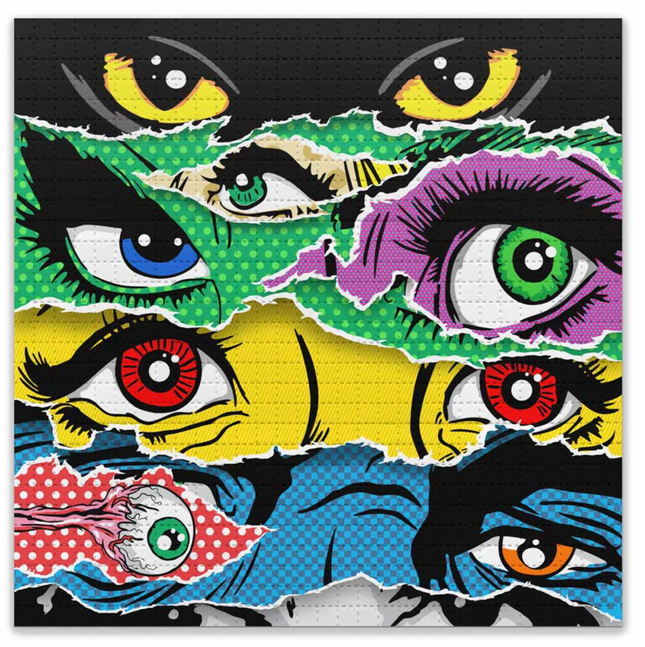
Denial- Daniel Bombardier The Eyes Have It Blotter Paper Archival Print by Denial- Daniel Bombardier
Not Again Blotter Paper Archival Print by Denial- Daniel Bombardier Limited Edition Fine Art Archival Pigment Print Art on Perforated Blotter Paper. 2023 Signed & Numbered Limited Edition of 25 Archival Pigment Print on Perforated Blotter Paper Size: 7.5 x 7.5 Inches Release: April 19, 2023 Limited blotter editions are hand-perforated by Zane Kesey. Perforated blotter paper is a type of paper that is commonly used in the creation of graffiti fine art. This paper is perforated into small squares or tabs, which are then used to create unique artwork prints. The printing process used for blotter paper artwork prints is similar to that of traditional fine art prints, with a focus on using high-quality materials and techniques that ensure the longevity and preservation of the artwork. Archival inks are used to ensure that the print will resist fading and discoloration over time, and acid-free paper is used to prevent deterioration and yellowing. Blotter paper artwork prints are popular among collectors and enthusiasts of graffiti and street art due to their unique texture and the fact that each print is a one-of-a-kind piece of art. They are often framed and displayed in galleries and private collections, and can be a valuable addition to any art collection. Blotter paper artwork prints are made by first creating an original artwork on a sheet of blotter paper using various mediums, the artwork is then scanned or photographed and digitally reproduced using high-quality archival ink and paper. To ensure that these artwork prints are archival quality, it is important to use high-quality materials and techniques in the creation process. This might include using acid-free paper, archival inks, and other materials that will help to preserve the artwork for many years to come. With proper care and storage, these artwork prints can be enjoyed by collectors and enthusiasts for generations to come.
$467.00
-

ZERO Skateboards Iron Maiden Piece of Mind Skateboard Art Deck by ZERO x Iron Maiden
Iron Maiden- Piece of Mind Limited Edition Silkscreen Skateboard deck art by street pop culture artists ZERO x Iron Maiden.
$206.00
-

Ryan Berkley Hedwig Giclee Print by Ryan Berkley
Hedwig Artwork Giclee Limited Edition Print on Fine Art Paper by Pop Culture Graffiti Artist Ryan Berkley. Ryan Berkley - "Hedwig" limited edition fine art digital print signed and numbered edition of 50 copies 8" x 10"
$103.00
-
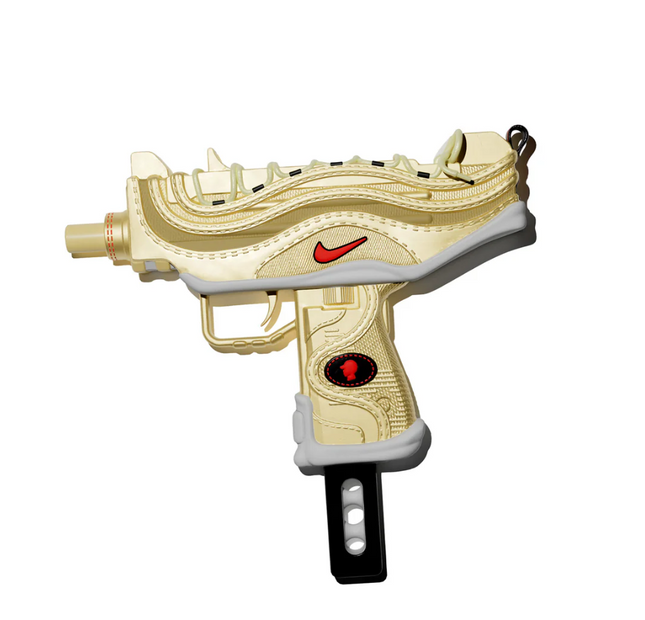
J-LDN aka Jack London Gold Bullet 75% Shoeuzi Art Sculpture by J-LDN aka Jack London
Silver Bullet 75% Shoeuzi Art Sculpture by J-LDN aka Jack London Hand Cast & Painted Polystone Uzi Art Toy Limited Edition Artwork Street Graffiti Pop. 2024 Bullet Edition in Gold Limited Edition of 200 Signed COA New In Box Size 75% 5x7 Shoeuzi Stylized Gun Shoe Art Sculpture by J-LDN aka Jack London. Polystone Resin hand-cast painted with Shoeuzi Magnafix magnetic assembly includes a 4-part set with gloves, a display stand, and a box for each Uzi sculpture. All pieces are still in their original packaging. The sculptures are 75% SHOEUZI, measuring 5x7, and ready to impress. The Gilded Statement: Gold Bullet Shoeuzi by J-LDN The Gold Bullet 75% Shoeuzi art sculpture by J-LDN, known outside the art world as Jack London, represents a unique blend of subversive creativity and polished craftsmanship in street pop and graffiti artwork. This 2024 release encapsulates the artist's keen eye for blending high-end fashion symbols with motifs of urban grit, delivering a statement piece that's thought-provoking and visually captivating. Artistry in the Form of a Uzi This piece, a poly stone resin hand-cast, and painted art toy, carries the distinct form of a Uzi submachine gun, stylized with elements of a sneaker in a gold color scheme. As a limited edition of 200, each sculpture has a signed Certificate of Authenticity (COA), assuring collectors of its legitimacy and exclusive status. The Shoeuzi Magnafix magnetic assembly—a four-part set including gloves, a display stand, and a bespoke box—speaks to the attention to detail and the consideration of presentation intrinsic to J-LDN's work. Each sculpture stands at 75% of the full Shoeuzi size, measuring 5x7 inches, making a compact yet powerful addition to any collection of contemporary art. These pieces stay sealed in their original packaging, ensuring their condition remains impeccable for art enthusiasts and collectors who prize mint-condition works. Cultural Implications of J-LVN's Work J-LDN's work reflects the cultural and social nuances that street pop art often seeks to address. The Gold Bullet Shoeuzi is a bold commentary on the intersections between urban violence and commercialism, wrapped in the luxury of gold—a color often associated with wealth and status. This art sculpture challenges viewers to consider the juxtaposition between luxury fashion and the harsh realities of street life, effectively using the language of street art to engage in a larger conversation about societal values and disparities. The Gold Bullet Shoeuzi also represents the dynamic nature of the evolution of street pop art, where the medium becomes a part of the message. By utilizing materials and methods common in creating mass-market collectibles, J-LDN aligns his work with the consumer culture it critiques, adding a layer of complexity to the artwork's interpretation. Conclusion: The Enduring Impact of Gold Bullet Shoeuzi J-LDN's Gold Bullet Shoeuzi is more than an art piece; it's a cultural artifact that captures the essence of street pop and graffiti artwork. It is a snapshot of the times, reflecting on commercialism, materialism, and the glorification of certain lifestyles while simultaneously embodying the aesthetics it critiques. Jack London's contribution to the street pop art movement through this work is a testament to the power of art as a medium for social commentary and change. The careful craftsmanship and the limited nature of the Gold Bullet Shoeuzi ensure that it stands the test of time as a sought-after piece for those who appreciate the confluence of art, culture, and commentary. As street pop art continues to challenge and shape contemporary art discourse, works like J-LDN's Shoeuzi sculptures will remain pivotal in sparking dialogue and reflecting the evolving narratives of our society.
$658.00
-
![[Not]WhiteChoc Bunnybot Canbot Canz Art Toy by Czee13](//sprayedpaint.com/cdn/shop/products/notwhitechoc-bunnybot-canbot-canbot-818644.jpg?v=1667828553&width=645)
Czee13 [Not]WhiteChoc Bunnybot Canbot Canz Art Toy by Czee13
[Not]WhiteChoc Bunnybot Canbot Canz Limited Edition Vinyl Art Toy Collectible Artwork by Street Graffiti Artist Czee13. 2022 Limited to 20 Solid 5oz Canbot Canz , New In Box. Sculpted by Czee13! Designed to look just like your favorite easter white chocolate bunny, complete with a side seam! Each of these pieces is lovingly hand-created in New York by Clutter Studios! This is a limited edition run of 20 pieces. Does Not Rattle.
$480.00
-
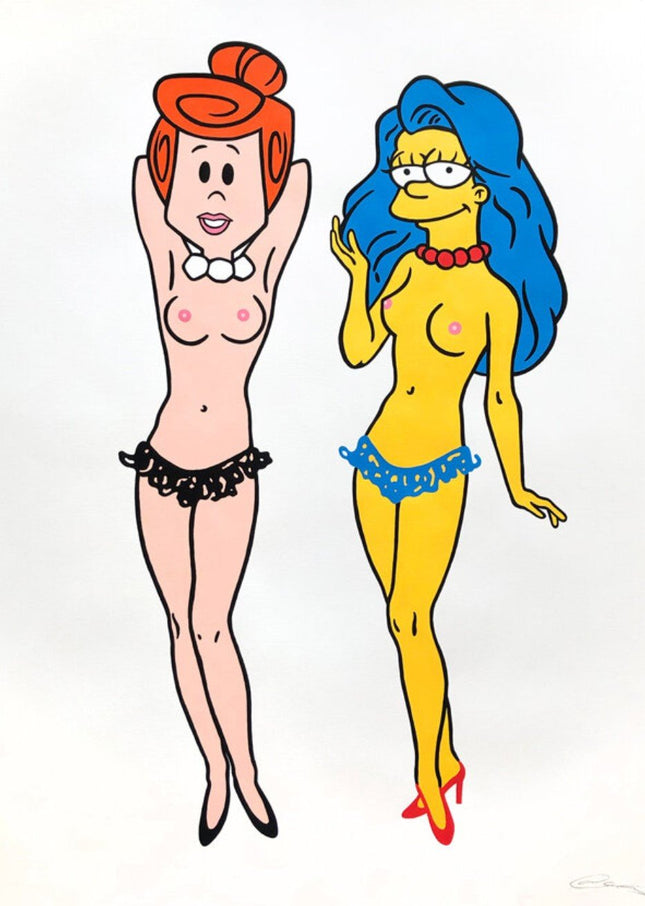
Aaron Craig- Pop Mash A Night On The Town Original Acrylic Painting by Aaron Craig- Pop Mash
A Night On The Town Original One of a Kind Acrylic Painting Artwork on 270gsm Acrylic Canvas Stock by Popular Street Graffiti Artist Aaron Craig- Pop Mash. 2021 Signed Original Acrylic Painting Artwork Size 21x29 Artwork Specifications Artwork dimensions: 54cm x 74cm (21” x 29”) Medium: Acrylic paint on 270gsm acrylic canvas stock Signed and blind stamped by Aaron Craig
$803.00
-
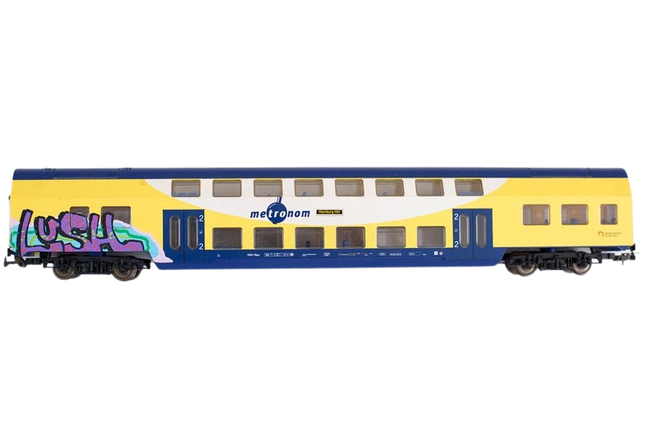
LushSux Train 39 HO Graffiti Train Art Toy Sculpture by LushSux
Train 39 Original Acrylic on HO Scale Model Train Box-Car Sculpture Artwork by graffiti street artist modern pop artist LushSux. 2014 Signed Original Graffiti Tag/Throw Up Painting on HO Model Train Car Artwork Size 14x3. Lush is a male model and sometimes an international graffiti asshole. "Train 39" by LushSux: A Model of Street Art Innovation "Train 39" is a captivating work by the contemporary street and pop artist LushSux, who has carved a unique niche in the urban art scene. This original piece, created in 2014, is a prime example of how LushSux transposes the essence of graffiti onto an HO-scale model train box-car, measuring a mere 14x3 inches. Through this work, LushSux continues challenging the conventional perceptions of graffiti by taking the once exclusively urban art form into new and unexpected domains. The signature of LushSux not only authenticates the piece but also denotes his dual identity as both a street artist and a self-proclaimed "international graffiti asshole," a testament to his tongue-in-cheek approach to his public persona. Exploring the Dichotomy of "Train 39" In "Train 39," LushSux juxtaposes the orderly world of model train collecting with graffiti art's often chaotic and free-spirited nature. The artwork features a vibrant tag or "throw-up," characterized by its bubbly letters and bold, outlined edges—a hallmark of LushSux's style. The interplay of colors and the strategic placement of the tag disrupt the traditional aesthetics of the model train, infusing it with a contemporary edge that is both striking and thought-provoking. This piece exemplifies how street pop art can extend beyond the walls of city buildings and into the more intimate spaces of personal collections, retaining its power to engage and challenge viewers. The Cultural Resonance of LushSux's "Train 39" The creation of "Train 39" and its subsequent release into the art market underscores the evolving nature of street pop art as a cultural expression. The piece reflects a broader trend in contemporary art, where the lines between high art and subcultural expressions continue to blur. LushSux's work on this model train encapsulated a moment in the street art movement when artists began seeking new frontiers and mediums. As a collectible, "Train 39" represents the intersection of various enthusiast communities, from graffiti aficionados to model train collectors, showcasing the universal appeal of LushSux's artistry. Through his innovative use of unconventional canvases, LushSux expands the reach of graffiti artwork, ensuring its presence is felt across diverse cultural landscapes.
$1,060.00 $901.00
-

Mateo Lina PP Printers Proof Archival Print by Mateo
Lina PP Printers Proof Archival Print by Mateo Limited Edition Print on MEDIUM Pop Artist Modern Artwork. PP Printers Proof 2025 Signed & Marked PP Limited Edition Artwork Size 17x24 Archival Pigment Fine Art Lina PP Printers Proof Archival Print by Mateo French artist Mateo, known for his transformative Street Pop Art & Graffiti Artwork, delivers a powerful cultural statement with Lina, a 2025 archival pigment print in a rare Printer’s Proof edition. Measuring 17 x 24 inches and produced on high-quality fine art paper, this print continues Mateo’s practice of merging portraiture with ornamental textile traditions. Signed and marked PP by the artist, this piece stands as a unique refinement in a limited body of work that celebrates identity, feminine strength, and transcultural visual language. Ornament and Identity in Harmony The subject of Lina is a woman whose direct gaze confronts the viewer with unwavering presence. Her face and form are partially obscured and enhanced by intricate Persian carpet motifs, rendered with exceptional detail and precision. Mateo seamlessly overlays these patterns onto the contours of the subject’s face, creating an illusion that her skin itself is interwoven with global heritage and ancestral memory. The blue and gold palette radiates dignity, serenity, and sacred geometry, inviting viewers to contemplate the beauty of complexity and resilience in modern cultural narratives. Technique and Material Craft The technique employed in Lina reflects Mateo’s signature synthesis of classical craft and urban art aesthetics. This Printer’s Proof was produced using archival pigment processes on 290gsm Moab Entrada paper, ensuring vibrancy and longevity. The embellishment of textile detail does not serve as mere decoration—it functions as a symbol system, deeply rooted in Mateo’s ongoing exploration of symbolism, heritage, and hybrid identity. The crispness of the print, coupled with its ornamental layering, produces a near-sculptural surface on flat paper. Contemporary Global Vision Mateo’s work challenges and expands the language of Street Pop Art & Graffiti Artwork by integrating references from North African, Middle Eastern, and Asian decorative traditions into contemporary Western portraiture. Lina is emblematic of this synthesis, embodying both the raw immediacy of urban street art and the sacred timelessness of cultural craft. The Printer’s Proof format of this edition adds a level of rarity and authenticity for collectors, and underscores Mateo’s emphasis on process, craft, and artistic integrity. Lina is more than an image—it is a meditation on feminine strength, history, and the interwoven layers of self and culture. With its meticulous construction and universal resonance, the work occupies a critical space in the canon of modern figurative and street-rooted fine art, making it a vital acquisition for collectors seeking narrative depth and visual impact.
$500.00
-
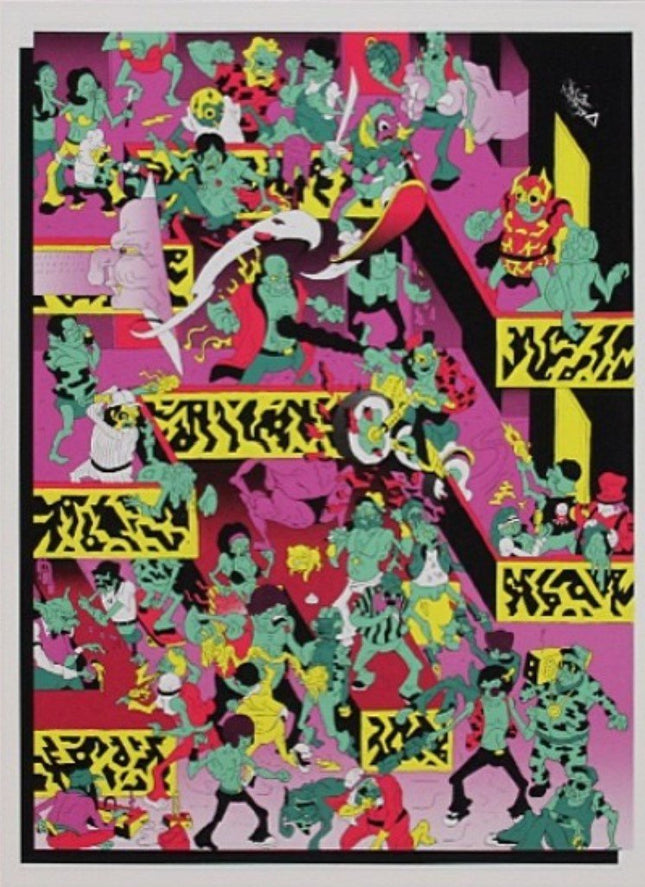
Pete Murgatroyd The Panzers Giclee Print by Pete Murgatroyd
The Panzers- Come Out To Play Artwork Giclee Limited Edition Print on Fine Art Paper by Pop Culture Graffiti Artist Pete Murgatroyd. Come Out To Play- an illustrated tribute series to 1979 cult movie classic The Warriors!
$217.00
-
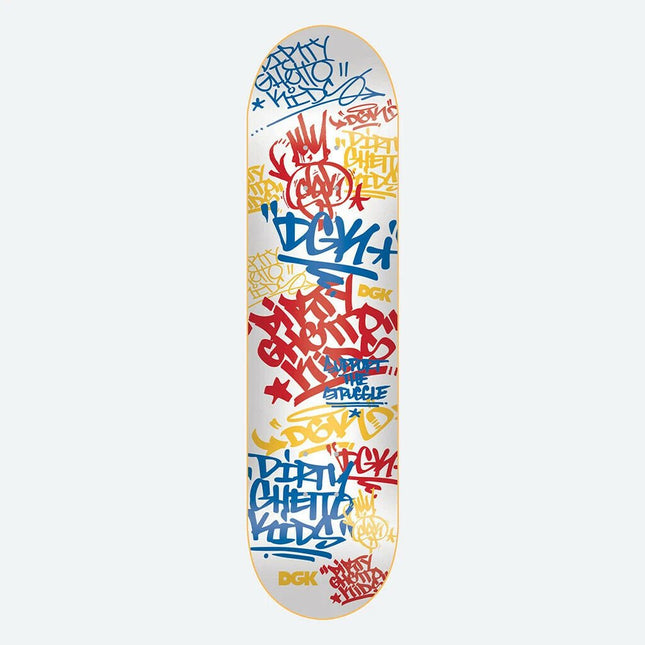
DGK Summer School 2 7.8 Skateboard Art Deck by DGK
Summer School 2- 7.8 Deck Limited Edition Silkscreen Skateboard deck art by street pop culture artist DGK.
$149.00
-
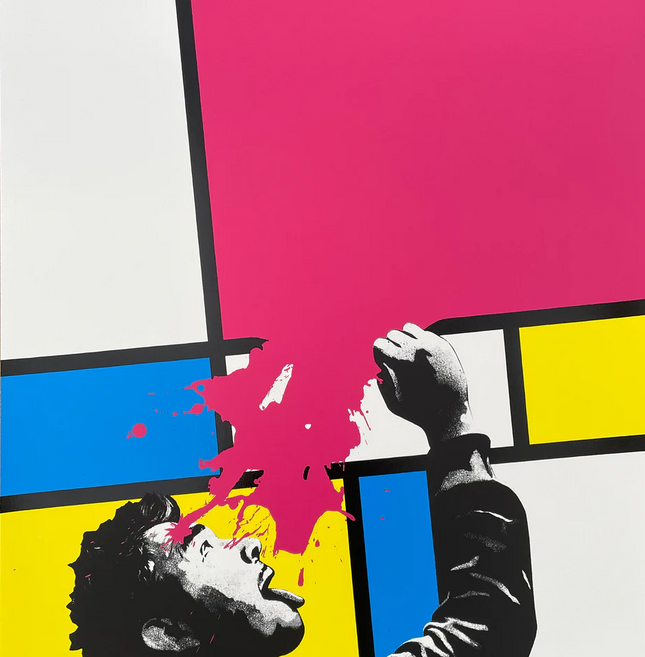
Kunstrasen Soak Up Art When You Can CYMK PP Silkscreen Print by Kunstrasen
Soak Up Art When You Can CYMK PP Silkscreen Print by Kunstrasen Printers Proof Hand-Pulled 6-Color on 300gsm Somerset Fine Art Paper Limited Edition Artwork. PP Printers Proof 2018 Signed & Marked P/P Limited Edition Artwork Size 19.68x27.56 Silkscreen Print. The "Soak Up Art When You Can CYMK PP" is a thought-provoking silkscreen print by Kunstrasen, whose work fluidly combines the aesthetics of Street Pop Art and Graffiti Artwork. Created in 2018, this piece is a Printers Proof (P/P), indicating it is one of the unique copies typically reserved for the artist's approval before the final edition is run. This status often makes the P/P prints more desirable due to their rarity and role in printmaking. The artwork is hand-pulled, a traditional technique that ensures each print has a unique touch, and it features a vibrant 6-color palette on 300gsm Somerset fine art paper, known for its superior quality and texture, enhancing the visual depth of the print. Kunstrasen's choice of the CMYK color model, a cornerstone of printing technology, cleverly bridges the technical world of printmaking with the visceral experience of viewing art. The dimensions of the piece, 19.68x27.56 inches, offer a substantial canvas for the artist's vision, where the striking interplay of color blocks and the depicted figure invites contemplation on the role of art in public and personal spaces. With its significant name "Soak Up Art When You Can," this print serves as both a manifesto and a reflection on the ephemeral nature of street art and the importance of engaging with art in all its forms. The work is both a literal and metaphorical splash of color against the structured backdrop of CMYK, suggesting the transformative power of art to disrupt and animate the routine patterns of life. The silhouette of the figure against the bold splashes of paint is reminiscent of graffiti's spontaneous nature, while the structured composition speaks to the calculated precision of pop art. Kunstrasen's work often resides in this dual nature, navigating the nuances between planned artifice and impulsive creativity. For enthusiasts and collectors, owning a piece like "Soak Up Art When You Can CYMK PP" means holding a snapshot of the artist's critical engagement with the world. This piece symbolizes the ongoing dialogue between the street and the gallery.
$951.00

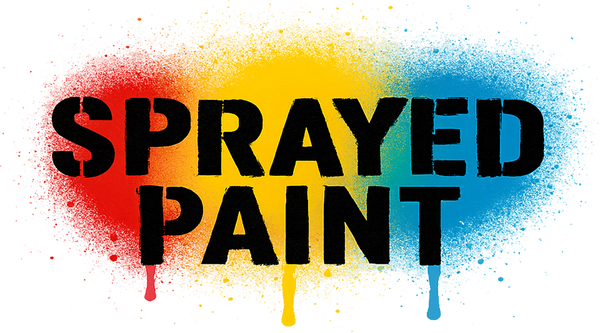









































![[Not]WhiteChoc Bunnybot Canbot Canz Art Toy by Czee13](http://sprayedpaint.com/cdn/shop/products/notwhitechoc-bunnybot-canbot-canbot-818644.jpg?v=1667828553&width=645)





